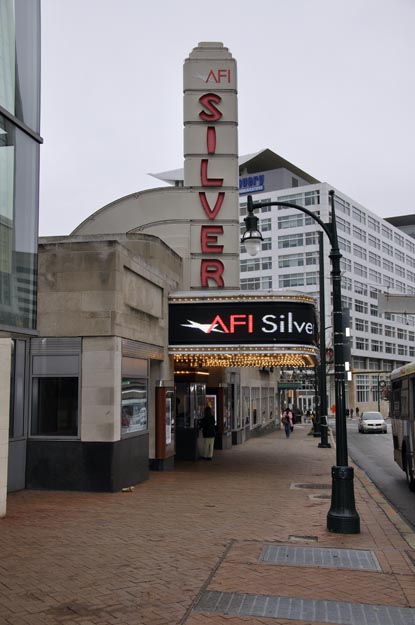
The AFI/Silver as it appears in 2009. It operates 7-days a week and shows most every type of motion picture entertainment, from classics to current fare. However, its current fate was far from certain.
The Silver Theatre was opened September 15, 1938 and designed by John Eberson. For the first part of its life, it was operated by Warner Brothers. However, it and its land changed hands for the latter part of its 1st life. It was then operated by the Washington, DC based K-B Theatres.
By the mid-1980s, time had run its course and the fate of the Silver was seemingly to follow in the footsteps of other theatres of its era now living in a Multiplex world. One thing it was spared, however, was being cut up into a quick and dirty twin, triple or quad. That said, it suffered its own unique disgrace.
The mid 1980s were years in which downtown Silver Spring, Maryland was building. The landlords of the Silver also wanted to develop their property. The problem being that the Silver and its adjoining shopping center were considered historical landmarks, though, at the time, not officially registered. The people of the area put up a stiff resistance. To keep the theatre (and other parts of the city block) from becoming too historical, “things” started to happen to the building. In the years and months prior to its closing, bits and pieces of the Silver were removed and destroyed! The “Silver” tower was not only removed but demolished to ensure it would not return. The Art-Deco features of the lobby, like the coves were hammered away and a modern drop ceiling installed. The awning lights were removed to be replaced by a much more simple (and cheap looking, yet modern) replacement. Finally, the Silver was shuttered in 1985.
The community and County won its battle with the landlords in that building boom of the 1980s passed and the Silver did obtain historic classification in 1988 but much damage was done.
Ten years passed and in 1998, Montgomery County Maryland decided to redevelop a depressed Silver Spring, Maryland with the Silver Theatre to be its crown jewel. The American Film Institute was to be operator of the Silver Theatre in the 21st Century. On April 4th, 2003 AFI/Silver Theatre and Cultural Center opens.
Fortunately, the jackhammers and other demo equipment did not have access to the original blueprints. For the “Silver” tower was recreated off the original designs with the addition of the “AFI” block above the “S.”

The Silver as it appeared in the 1950s and in 2009. The “Silver” tower lives again!
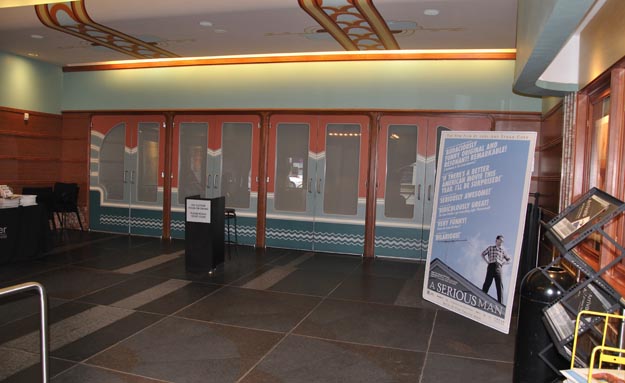
The outer lobby has been restored with its Art Deco coves.
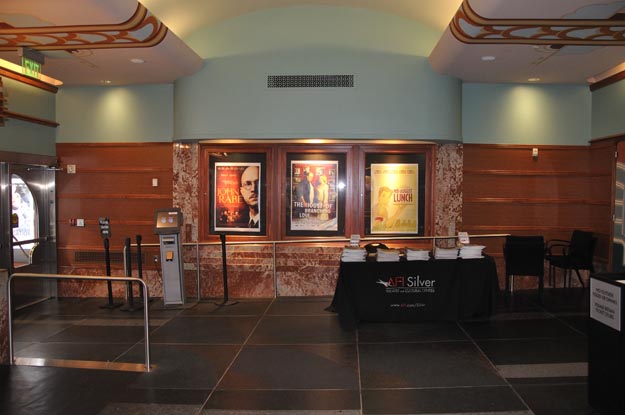
Outer lobby poster cases.
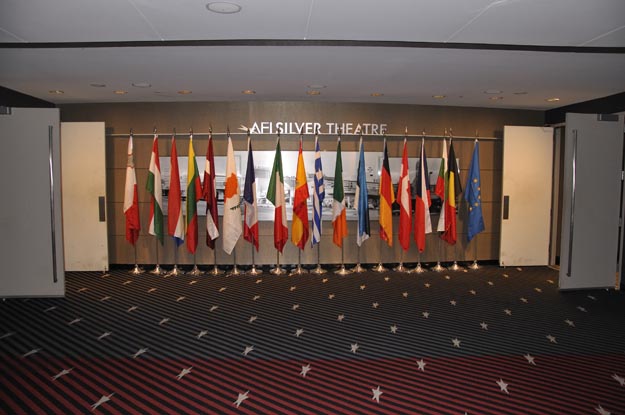
Inner Lobby. The flags are on display for the European Union Film Festival.
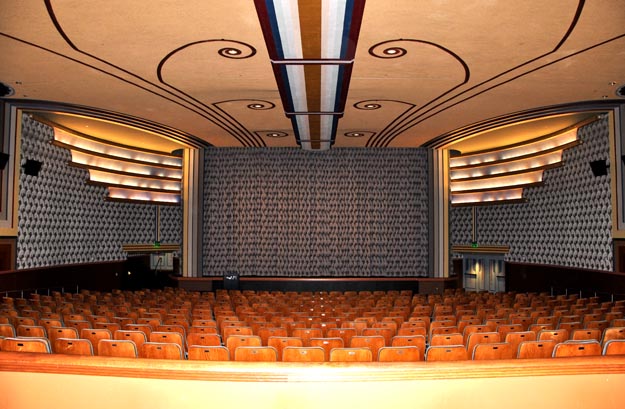
The Historic Theatre (A.K.A. Silver 1)
Originally seating about 1000. It now only seats 400. But with about 4-feet from seat-back to seat-back, it is a very comfortable theatre. The architects for the rebirth of the Silver were from the Gensler firm. The A/V aspects of the complex were designed by Boston Light and Sound.
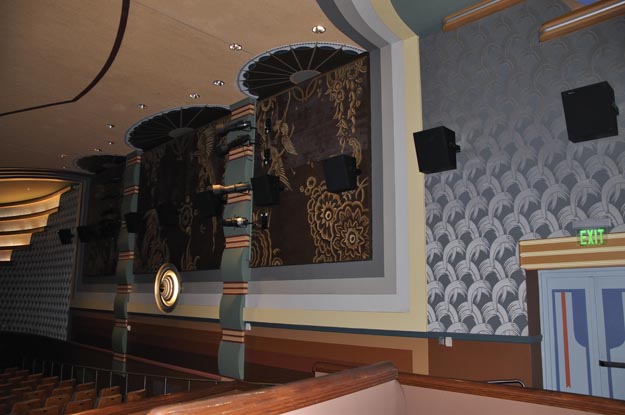
The Historic Theatre’s right wall. There is definitely a mixed view of the surround speakers. Though certainly not original, the feeling was that they did not permanently damage the room and they brought “state-of-the-art” sound to the room. Thus, they were a net plus. One of the features of the Silver’s original design becomes more apparent in this picture. That is, there is a nautical theme to the building (note the circular light fixture on the side wall).
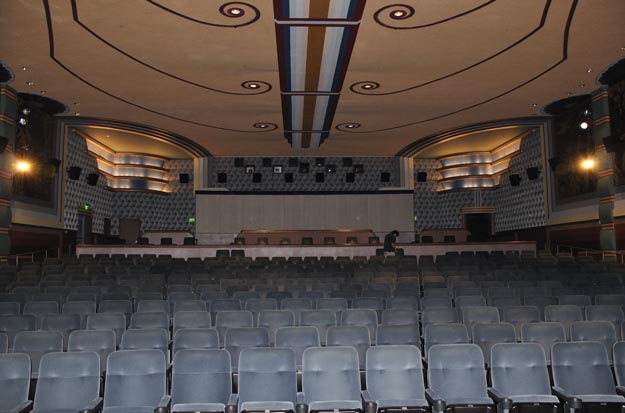
Looking back towards the booth, one can also see the light/sound lock that did not originally exist. This also contributes to the lower seat count than the Silver historically had. Just above the rear surround speakers (this theatre does feature Surround-EX and is THX certified like the other theatres at the AFI/Silver) are the projection/view ports. All five sets of ports are filled with projection equipment.
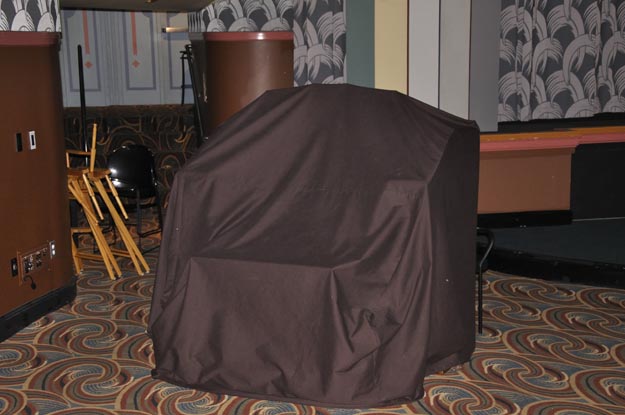
The theatre organ accompanies silent movies. Note too, one of the many A/V plates where video cameras and other A/V equipment may be patched in. These plates exist all over all three theatres and many special events receive the full production treatment. Similar access points are also available for audio mixing to be done within the theatre for live events (the AFI/Silver is not limited to just movies!).
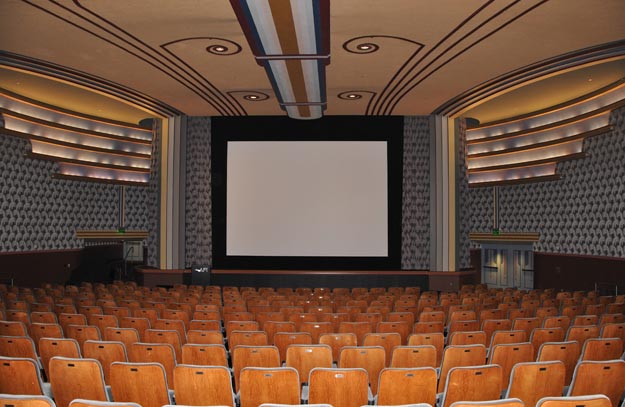
One of the tricks the Historic Theatre must accomplish is have the old-time feel of a 1.37 front-end when showing classic films. Note that the Art Deco color stripes from the ceiling continue down the panels or “walls”, as they are referred, on either side of the screen. In this setting, front-end takes on a more squarish appearance.
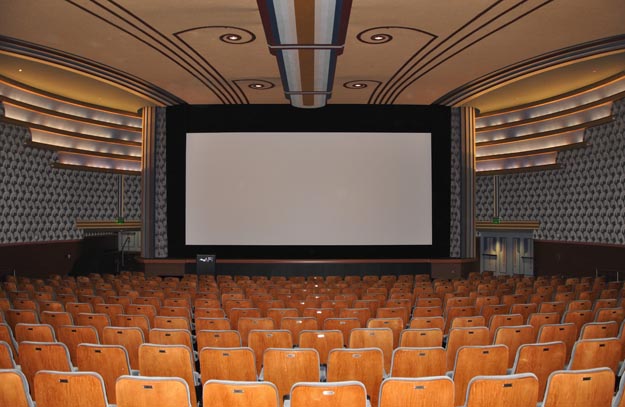
However, the Art Deco walls move to allow for wide-screen movies, including 70mm to have a more appropriate sized screen and still look “correct” for this type of auditorium. The maskings move on the sides and the top.
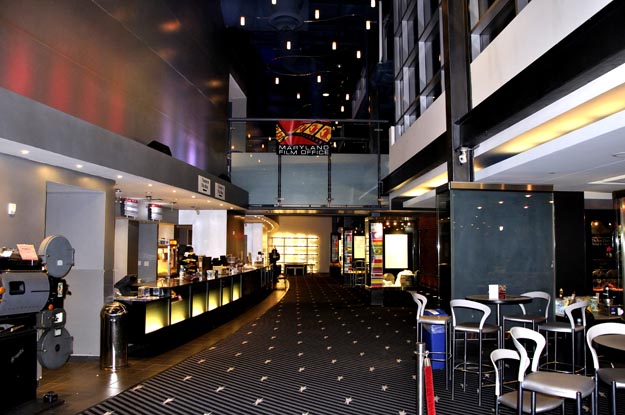
Moving across the lobby to the new theatres. Above you can see the “bridge” which literally bridges the 2nd floor between the two projection areas. But figuratively it bridges the Historic to the Modern areas too. In fact, to the right, you can see what was once exterior brick of the Historic Theatre. To the extreme left of this picture is Silver III and down the hallway and also to the left is Silver II (they are back-to-back theatres).
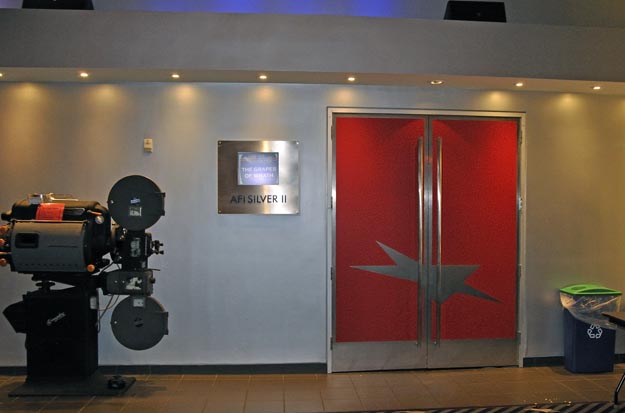
The entrance to Theatre #2. Video monitors provide information as to what is showing. These are outside of all three theatres.
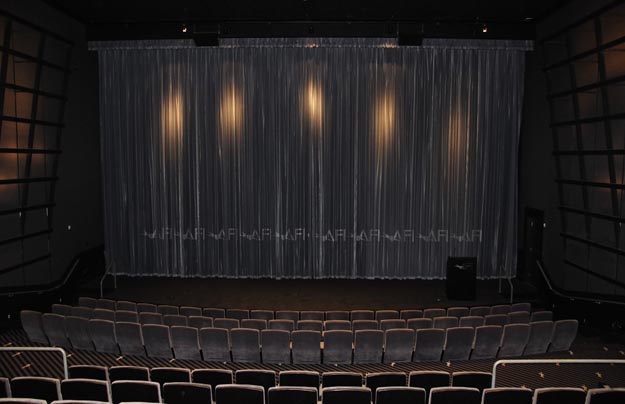
Silver II. Probably the best theatre to see a movie. Acoustically, it does not suffer from accommodating Art Deco features that cause bizarre reflections in the Historic Theatre. Also, the darker color of the fabric/seats in this theatre makes for a darker theatre while watching a movie.
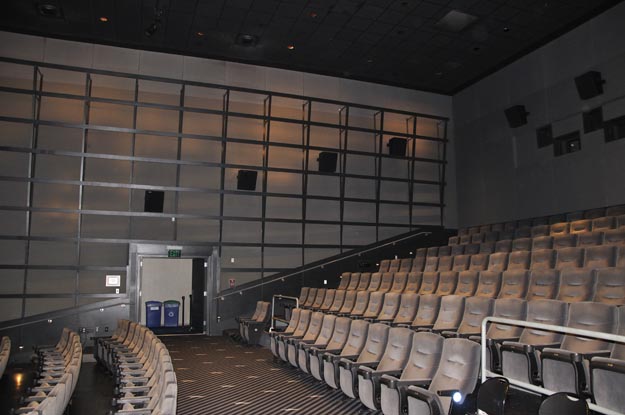
The two new theatres do not share the features of the Historic Theatre and instead went with a more modern design and clearly stadium seating.
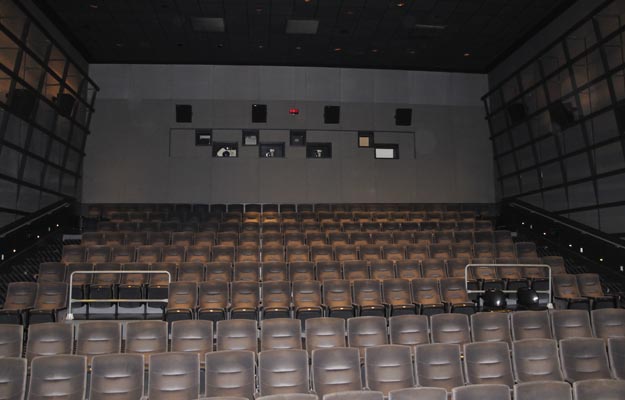
Theatre #2 looking back at the projection room. Just 4 sets of ports and only three sets are filled. Note the lattice on the side walls are in “3-D.” This theatre is a “Center-loader” so even disabled people get to be in the middle, more or less.

Like the Historic, the other two theatres must be able to present most any format. All four sides of the masking move to maximize each image’s size and also be comfortable to view. This is the 1.37 setting.
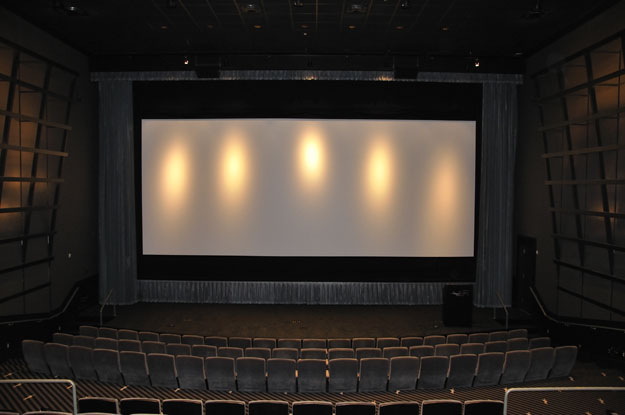
Theatre #2 in “scope” mode. The screen is just under 40-feet wide.
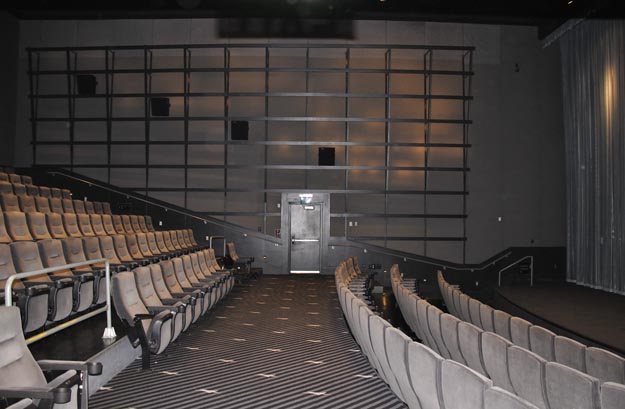
Theatre #2 seats 200, rather spaciously. The screen is rather large appearing but well sized for the auditorium. In the distance, one can see one of the A/V access plates on the side wall of the theatre. Also in the distance is another A/V plate on the side wall of the stage for live performances.
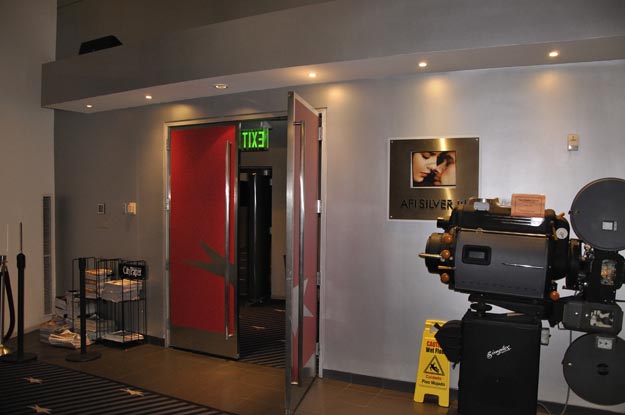
Theatre #3 entrance, located at the entrance to the lobby from the street (the AFI/Silver has two entrances. One through the Historical lobby and one through the modern lobby).
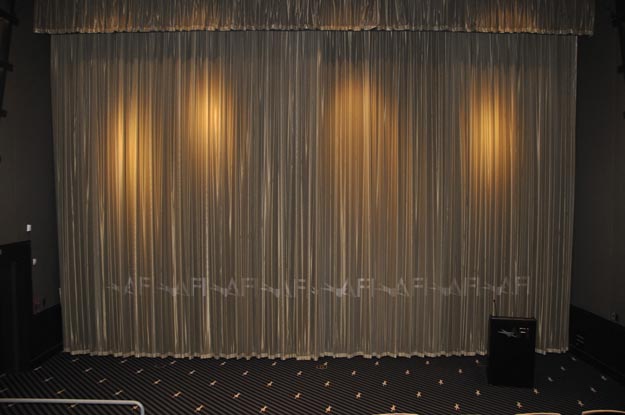
Theatre #3 is a smaller version of Theatre #2. The brighter golden color of Silver III also makes it popular for meetings.
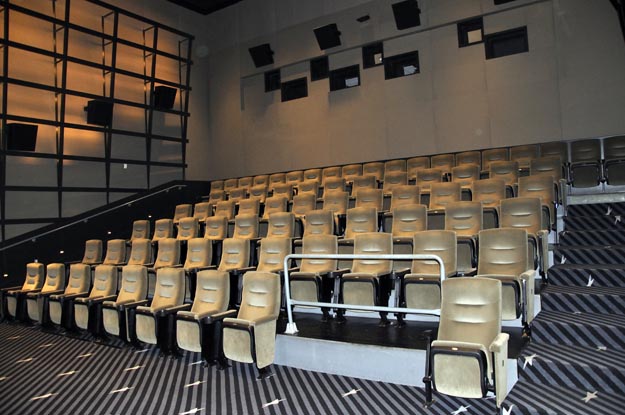
Theatre #3 seats 75 yet retains all of the A/V capabilities of its bigger siblings. As such, the AFI/Silver can provide an appropriately sized auditorium for any size group or audience. One need not feel like they are in a large cave for smaller functions.
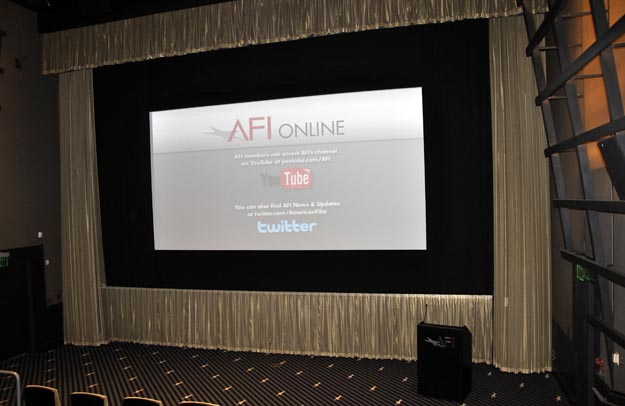
All four sides of the masking system move to accommodate most any format of film or video. And yet, provides a large and comfortable picture for the theatre size. Though not a raised stage, the large spacing between the seating area and the screen does function as a stage. The seating design was to allow for good views even without a raised stage in this theatre.
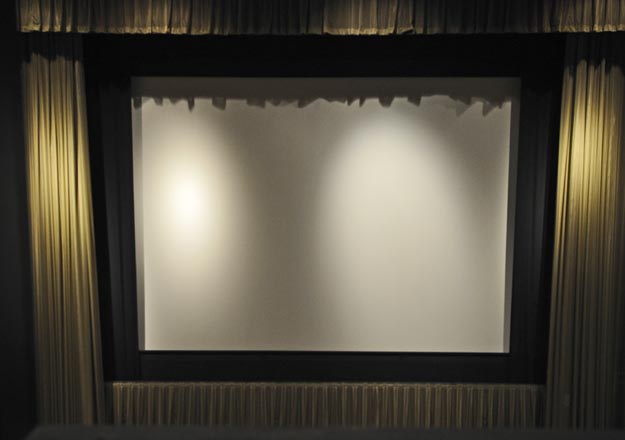
Like its siblings, Silver III can also do the 1.37 format proud. In fact, the 1.37 format is a very large appearing format.
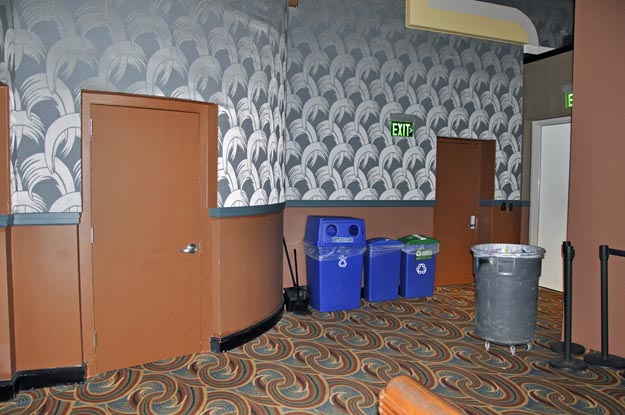
This picture is included not to show off that the AFI/Silver has waste receptacles, but to signify that is time to go to the booth. Some things have not changed since 1938. One of those things is the projection booth access door and for those that remember the old K-B Silver will know which door leads to the booth.
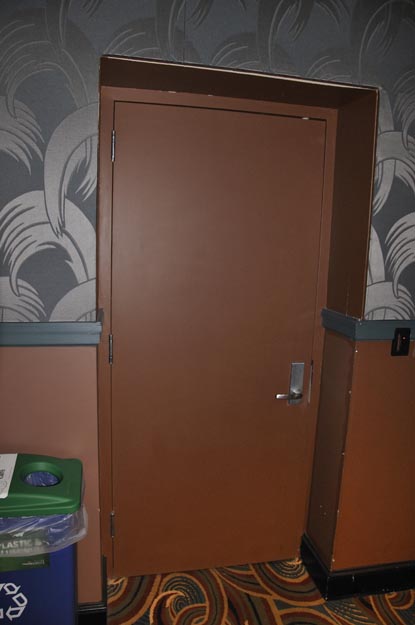
This door, in particular. While the door has changed (and widened)…
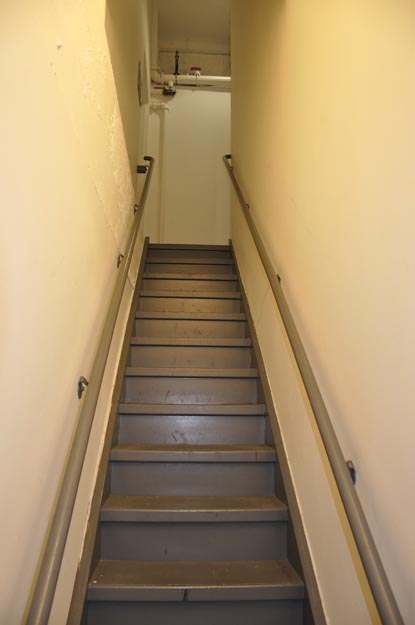
The stairway and the climb to the booth has not changed in over 70 years.
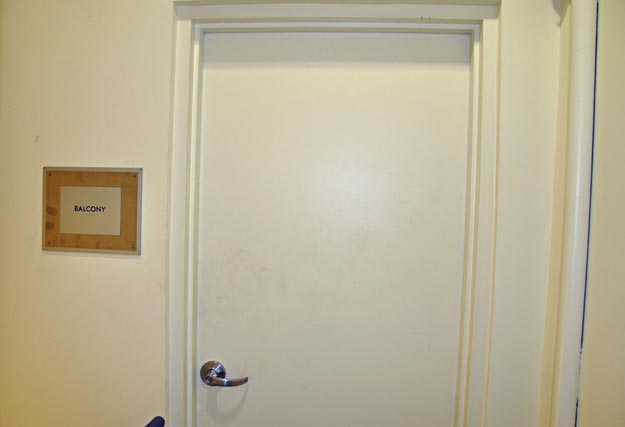
At the top of the first flight of stairs to the booth we take a brief pause to take note of the door that leads to the “balcony.” For the record, the Silver does not nor never has had a balcony. It is a storage room and has been used as office space or employee room in the past. So moving on…
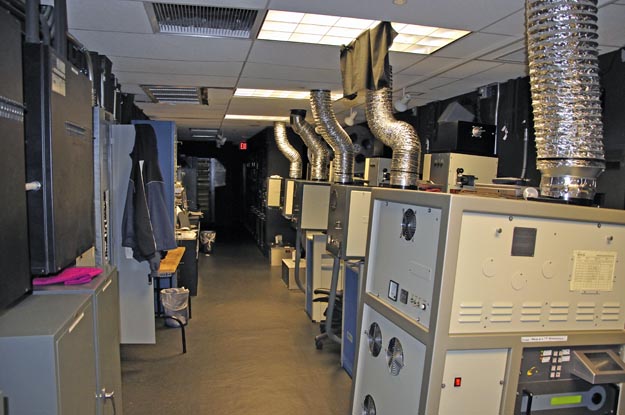
And finally, upon exiting the second flight of stairs one emerges into the Historic Theatre’s projection room.
The projection and sound installation (including video and PA) took approximately 6-weeks from start until the first shows. Full functionality took some months longer but also had to be worked in around the show schedule.
Pictured here, on the right, are the four film projectors and one DCinema projector (note, in 2003, when the AFI/Silver opened, the Barco DP50 was the current state-of-the-art). There are two pairs of film projectors with two Kinoton FP75ES and two Kinoton FP38ES. Any projector may “changeover” to any projector though they almost always work in like-pairs. They can also perform a 3-D changeover as each pair can run in a dual-strip 3-D mode. This feature may also be used for evaluating multiple copies of the same movie.
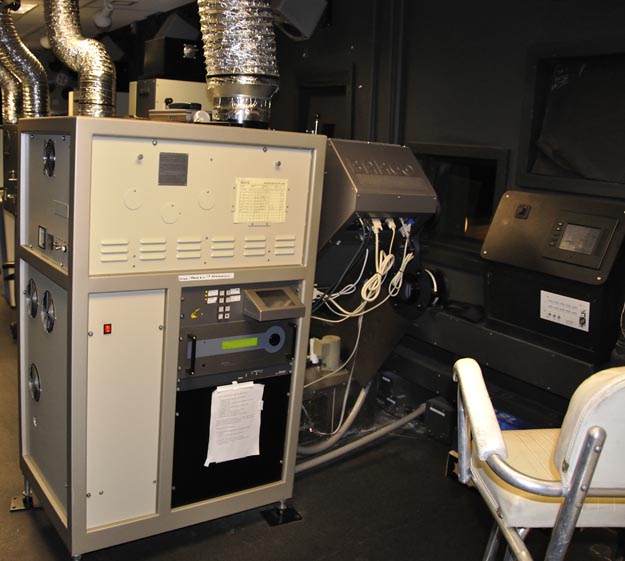
The Barco DP50 still provides all of the video presentations. The DP50 is outfitted with the Barco ACSAR which provides seamless switching between both digital and analog sources, HD and SD. The Macros in the DP50 are set up such that 5 Macros cover well over 95% of all presentations with ratios ranging from 4:3 to Scope at 2.39:1. On the right one can see the portal control panel with a Crestron touch panel and intercom system. The Crestron system takes care of controlling the ACSAR and always has the proper source selected and formatted. The operator is responsible for anamorphic lens changes (in a 1st generation DCinema projector, two anamorphics are used (1.5X and 1.9X) to create all ratios other than 5:4 (SXVGA, 1280x1024)).
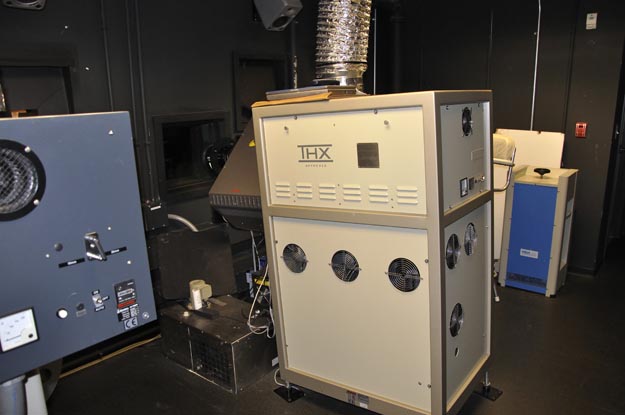
And yes, the DP50 was THX approved.
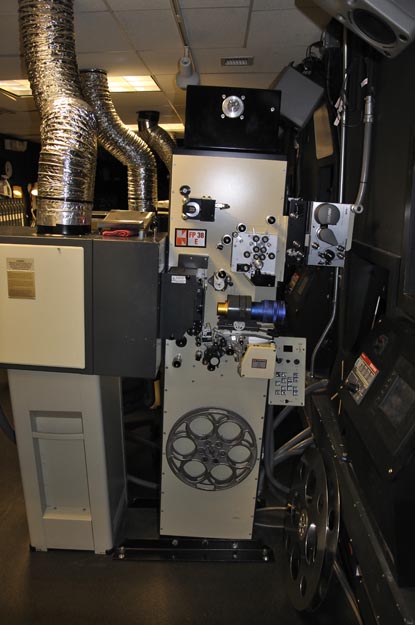
Projectors 3 and 4 for Theatre #1 are the FP38ES by Kinoton. In addition to being some of the finest projectors in the world with rock steady images, these projectors are also very flexible. Note the three digital readers for DTS (upper-left), SDDS (upper-right, turned vertical), and Dolby Digital (in the optical soundhead, lower-right). Additionally, the spindles may be quickly changed between 5/16” for 2000’ reels (rep or archival) or ½” for 6000’ reels (1st run), as well as 5/16” square for 16mm.
The control panel on the right of the projector also has the real-time frame-per-second readout. These machines will project anywhere from 12-30 frames-per-second. They can also shuttle the film in either direction up to 100 frames per second. They accommodate 35mm and 16mm film. The 16mm soundhead is in the upper-right (above the lens). Note the proper davis type tensioner for 16mm that is actually superior to most 35mm soundhead designs. 16mm does not take a back seat on these projectors. The 16mm sound must be delayed since it is read before the picture is shown. Theatre #1 runs on special 4500-watt lamps (outputs about the equivalent of 5800-watts) for the 35/16 machines without damaging the 16mm film.
On the right, one can see the Dolby CP200’s Cat 204 remote, the Crestron touch panel and in the extreme upper-right, the JBL LSR series monitor speaker.
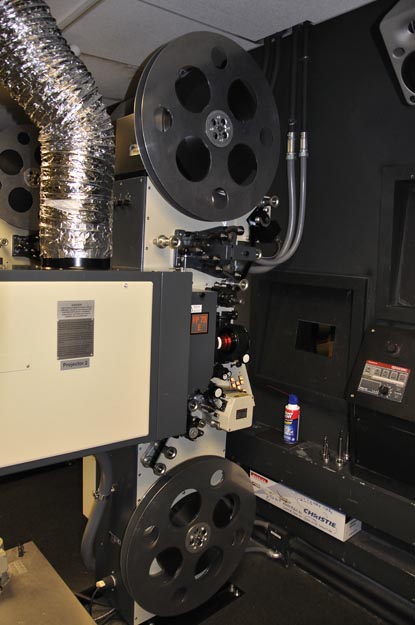
Projector 1 and 2 in the Historic Theatre are the Kinoton FP75ES. They offer essentially the same features as the previously mentioned FP38ES except they are for 70mm and 35mm film. These projectors are equipped to play 70mm and 35mm magnetic sound as well as 70mm and 35mm DTS and 35mm Dolby Digital audio. Spindles may be quickly changed between 35mm 5/16”, 35mm ½” and 70mm ½”. Xenon lamp size is 6000-watts.
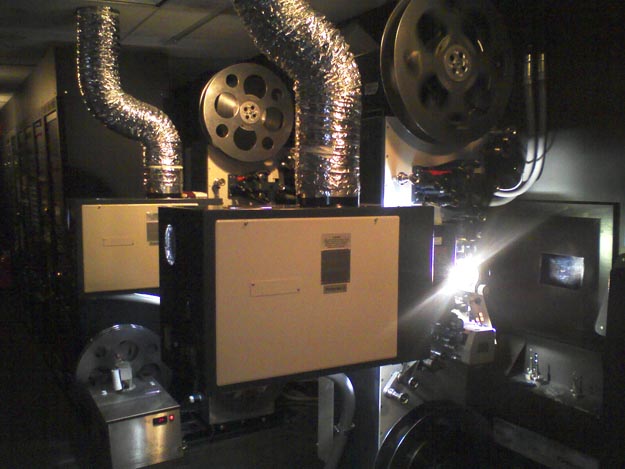
Running 70mm and DTS.
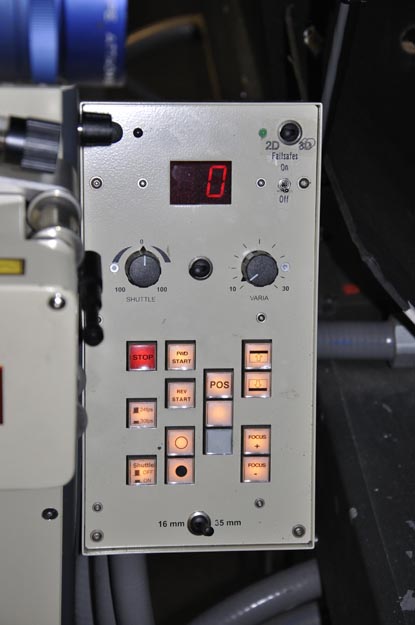
Close up of the Kinoton control panel. The green LED next to the 2D/3D switch denotes when the two projectors are in sync and in 3D.
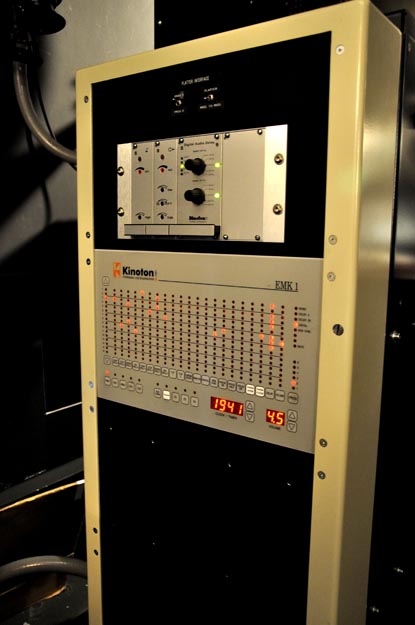
The backside of the Kinoton FP38ES Projectors showing the EMK-1 automation (similar to the Pennywise CA21). In the Historic Theatre they are the 3-D version, in the other theatres they are the “Rock and Roll” version. Above the automation is the 16mm sound preamps (mag and optical) as well as the digital audio delay since the soundhead is located before the picture gate.
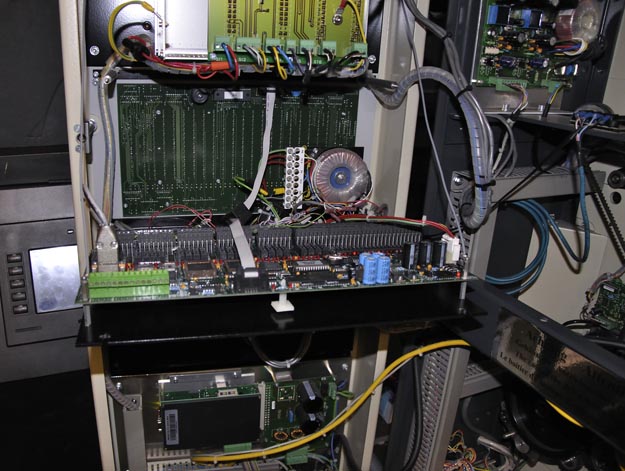
Looking inside of the FP38ES, we see 16mm preamp/delay at the top and the EMK-1 (CA-21) automation (opened for this picture). A lot of automation is compacted into a pretty tight space.
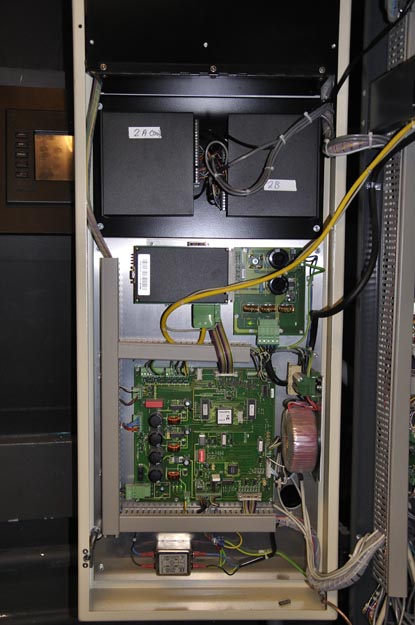
Moving down, the EMK-1 is now closed up. One can see the Crestron interface boxes, power supply, intermittent controller (MDE-12) and main board for the projector.
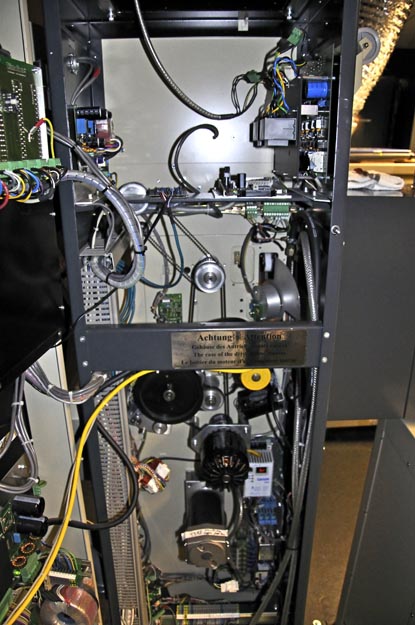
Inside the projector itself. On the upper-left one can see the LED and preamp supply for the 35mm optical sound. The upper right has the “friction” controller (reel drive). The reel motors are controlled from this board without aid of “dancer arms” or other mechanical connection to the drive sprockets. The main board communicates to the friction board to convey film format, speed and mode. The friction board also gets feed back from the friction motors to ensure smooth and even tension from beginning to the end of the reel.
Since these are “studio” grade projectors, they also incorporate the “studio soundheads” with magnetically coupled flywheels. The controller board, located just below the friction board on the cross member of the projector, monitors projector mode, film speed and flywheel speed. If the projector speed is changed from the current speed, the flywheel is decoupled, a motor is pulled in and the flywheel is accelerated/decelerated as necessary and when the speeds match, the flywheel is recoupled. In this manner, the sound drum never slips upon the film and the normal ramp up requirements to get the sound drum up to speed are not needed. For normal projection, the flywheel is spun up to speed the moment the projector is started and waits until the sprockets catch up to couple the flywheel.
The sprocket motor is controlled by the inverter (white box in the lower right). In this sense the projector behaves like most others.
The shutter is always spinning when the projector is powered on. Its speed is determined by speed of the film. However, since there is no mechanical connection to the sprockets, the projector is free to have the shutter behave like a single, two or three-wing shutter despite it physically being a conventional 2-wing bow-tie type shutter. For speeds below 20fps, it functions as a 3-wing shutter so all presentations are flicker-free and maximize light. It can change modes on the fly too. The yellow object just below the support bracket with the yellow cable is the intermittent motor/encoder. The main board ensures the shutter and intermittent work in harmony.
The intermittent can function as a constant feed or intermittent so when the film is shuttled, it is moves through the skate area in a constant flow rather than intermittently. In fact, when the machine starts up, it moves the film constantly until it is up to speed and then switches to intermittent mode.
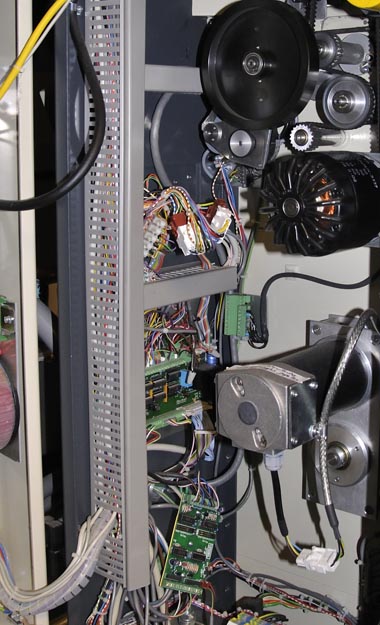
Since these projectors have automations built in, there are more than the normal amount of wires inside. However, they are pretty easy to integrate into most any system. On the left is the “interface” board that provides a means to control or monitor the projector.
Towards the bottom is an additional board Cardinal added to deal with shrunken or deformed film. The film break sensors are optical (no film contact) however some prints will have more curl or even try to twist back and forth. These boards allow for an adjustable delay before declaring a film break (from 1-8 seconds, independently set for the upper and lower sensor as well as the option that both sensors must declare break before issuing a break to the projector. The operator can even defeat the film-break sensors entirely, if need be (handy on automated shows when one is changing the features and one doesn’t want the automation to notice the absence of film in either projector. One can also see the flywheel accelerator motor just below the flywheel.
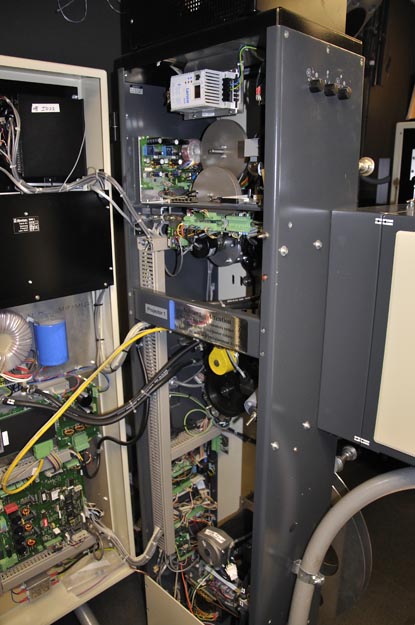
Looking inside the FP75ES (35/70) one will see much of the same things as the FP38. However there is the addition of the 35/70 magentic soundhead and its corresponding flywheels. The shutters, which operate similarly to the FP38 use a second 3-phase motor and inverter drive (white box at the top of the picture). The shutters are of the double-dissolving type and driven via belt.
In the FP75ES, the intermittent motor and controller (MDE-24) are added to the water cooling system. In fact, the water must be kept around 18C (65F) +/- 2C. There is a water flow circuit that will shut down the machine if sufficient water flow is not present.
Mounted to the main board is the 3D coupling board (lower right corner of the main board).
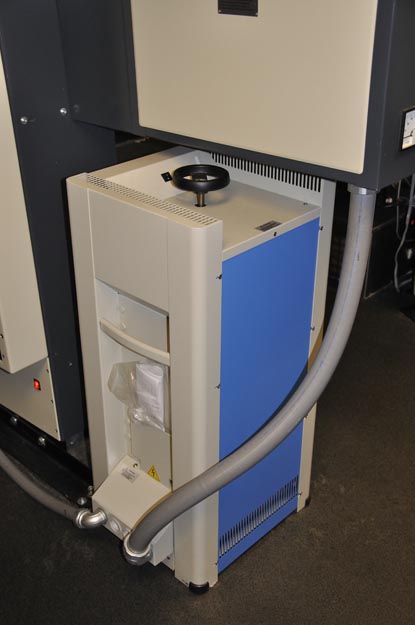
All of the xenon lamps are powered by IREM N3-180s except theatre #3 which has IREM N3-150s.
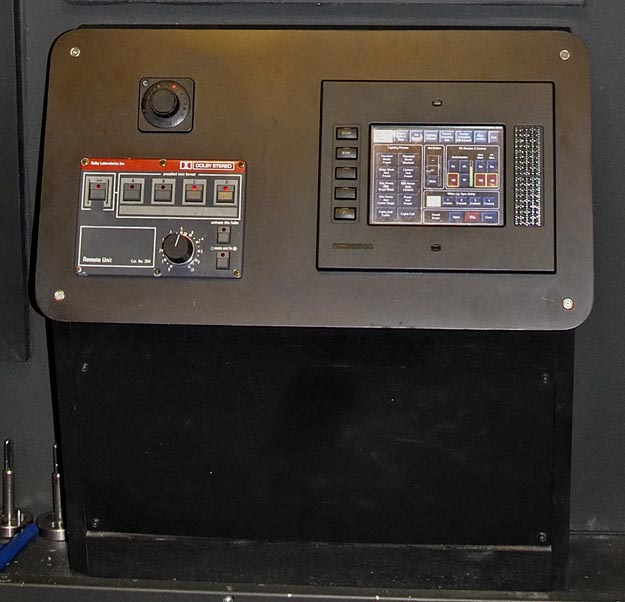
Portal Station in the Historic Theatre. CP200 Cat 204 on the lower-left, Booth Monitor control (Oxmoor, similar to Imax’s Sonics) in the upper-left and the Crestron touch panel on the right. One should note, the AFI/Silver uses multiple independent systems for most operations, thus the failure of any one, a very rare occurrence, may change the operation but does not affect the other systems. The sound can be controlled by the Cat 204 or the Crestron (or the EMK-1), for instance.
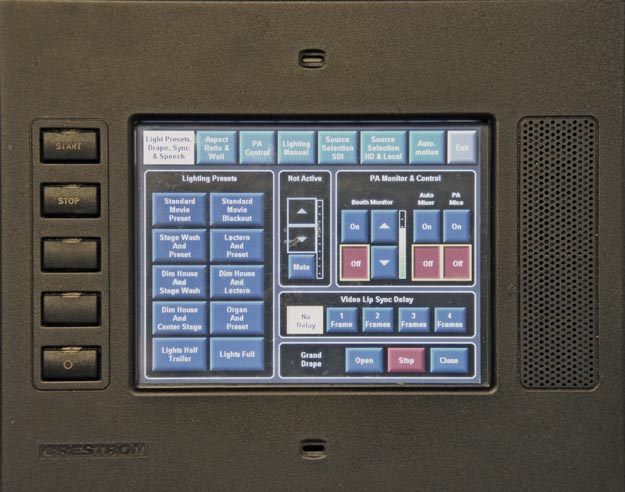
The main screen at the portal touch panel. Here the operator finds all of the normal controls they will need during a typical start or finish of a performance. On the extreme left are the hard buttons for controlling the projector the touch panel is next to (film or digital). In the case of digital, the “start”/”stop” buttons will control the currently selected VTR. The small circle button is the douser open button. It is opposite from the Start button to ensure the projectionist can tell by feel where they are without taking their eyes off the screen.
In the touch panel proper (the same controls are available at ALL port locations), on the left, are the lighting presets, next is the Crestron fader level (not active in this picture as the CP200 retains full control via the Cat 204s…note, the Creston knows if it has control or it doesn’t). Moving over, the operator may mix the PA system into the booth monitor feed and adjust its relative balance. Next to that they can turn the PA system on or off. In a latter screen, the operator can preset the PA as to what mics are needed so a single on/off can call that preset up for Q&A after a performance and without having to punch around the touch screen menus during critical timing situations. Below the PA controls are the lip-sync controls. Thus, during a digital performance, the operator, while looking at the screen, may set lip sync as needed since the latency tends to vary depending on how the video was processed. Lastly, the grand drape control.
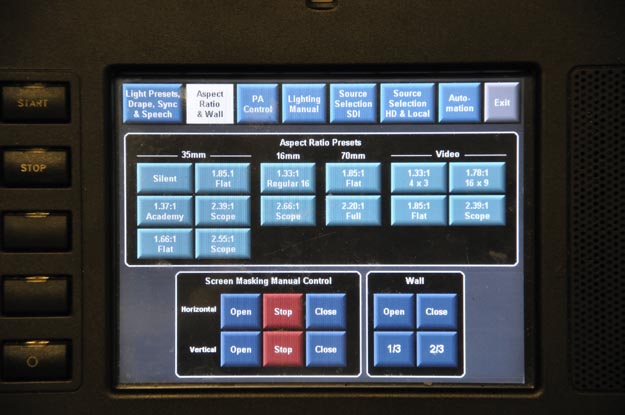
Masking Presets. In addition to the common formats, the projectionist may manually set the maskings as needed for special performances or if the masking stops have drifted. The “wall” refers to the Art Deco panels on either side of the screen which move apart for wider ratio movies. Maskings (and sound) may also be programmed to change when the next projector (film or video) opens its douser.
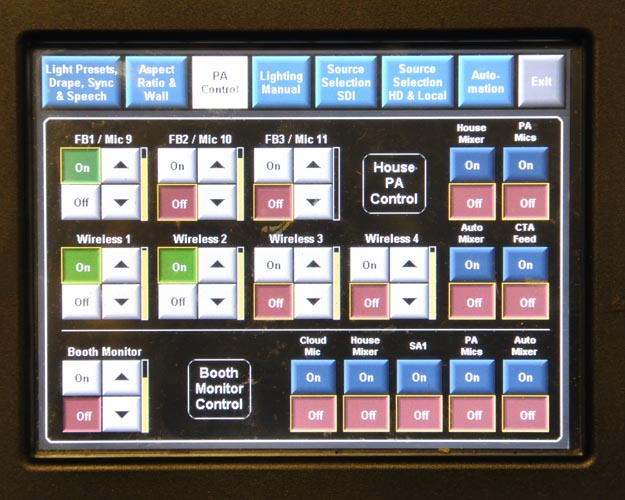
PA Preset screen. It also allows the projectionist to choose what of the PA system is sent to the booth monitor. During rehearsals, the levels should be trimmed for ideal levels. Thus, a single activation from the main screen puts the PA system on line with everything set as the operator desired.
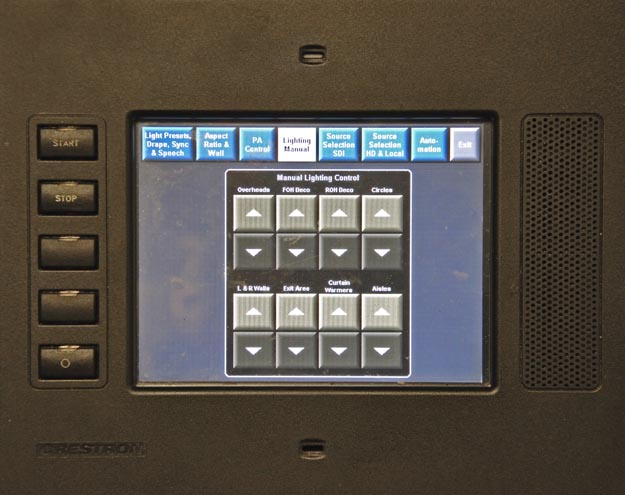
Manual Lighting Controls.
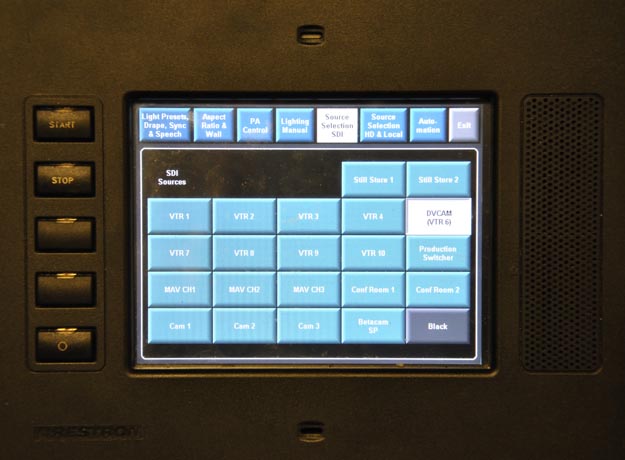
Unlike most theatres, the AFI/Silver has a great many video sources to choose from on any given show. This is just the first page and does not include the sources that are located in same booth. There is a Central Technical Area (CTA) that houses most of the VTRs in the facility.
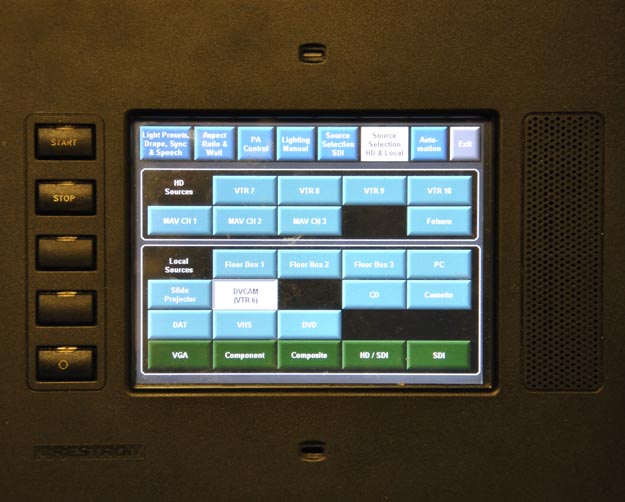
The remaining sources are the local ones as well as the HD sources. The green row at the bottom are for those sources that are temporary. There are jacks for each type of video type supported to plug in a rental deck or even just a laptop brought in for a specific show. In addition to the jacks in the booth, there are also floor pockets in each theatre where computers and other sources may be plugged in and selected.
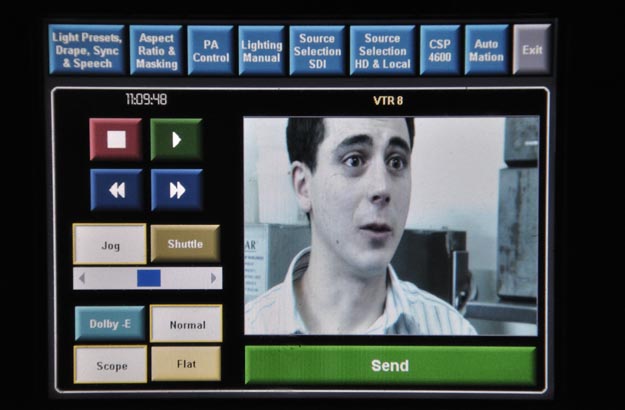
Once a source is selected, a suitable screen is opened up that provides what is needed to cue up or control that particular source. In the case of a VTR: a video monitor, timecode, transport controls…including jog and shuttle. Additionally, the projectionist selects the sound encoding and if it is scope or flat (Theatres 1 and 2 have 5 screen channels and use LC and RC for “flat” videos…particularly 4:3 material. When everything is cued, pressing “Send” will send it to the room or just to the projector, if its douser is closed, so seamless changeovers between film and video may be performed.
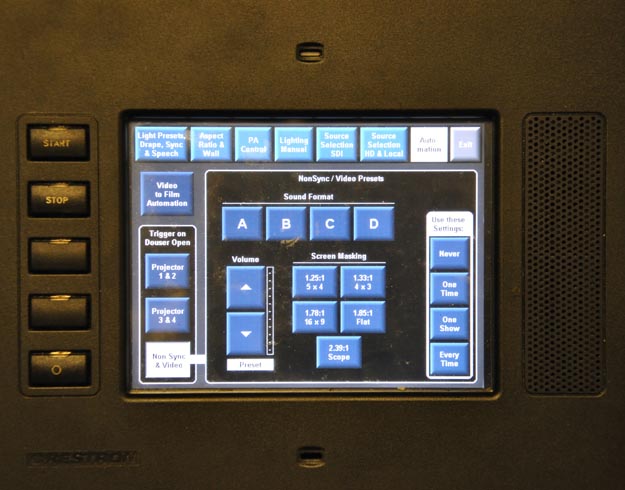
The “automation” screen is tailored to the specific theatres. In theatre #1, there is a Dolby CP200 so the A, B, C, D presets may be used. Separate volume settings may be preset for each pair of projectors as well as the video and non-sync. The CP200 communicates with the Crestron to let it know which projector is active or if Non-Sync/Video is active. Here, masking presets may also be loaded in. When the douser of the respective screen is opened, the presets are executed. This can be done just one time, at each changeover or just for one show. The projectionist can decide just how much automation they need for a particular performance…anywhere from full manual to completely automated, including video/film handoffs and even turning on the lights and PA for Q&A afterwards.
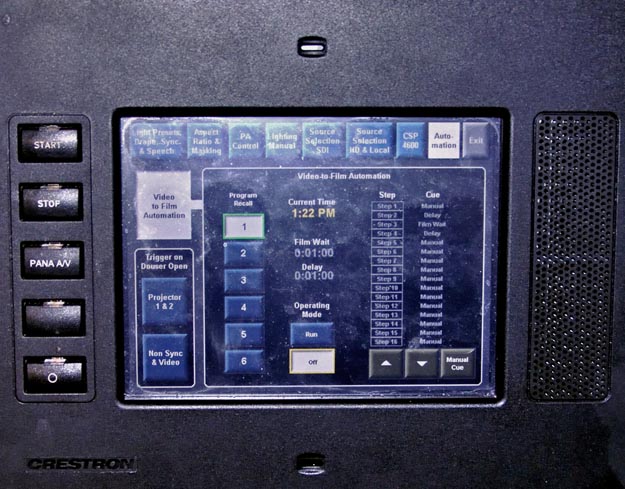
From the Automation screen, one can choose from 1 of the 6 programs (already configured at the rack touchscreen). One can enter/leave automated control or move to the desired step. The type of function executed at each step is also indicated.
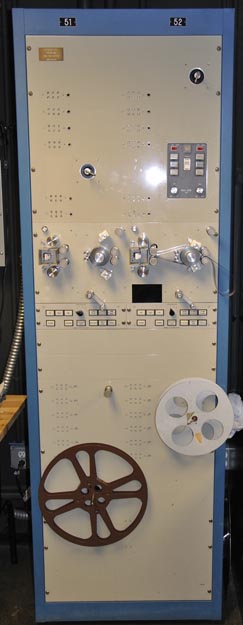
Rarely used, the AFI/Silver does have its own dubbers that can run 35 or 16mm full coat. They can support 16mm edge and center track as well as 35mm single though 6-track. Each head has its own dedicated preamp module in the soundrack. The dubbers are set up so any pair of projectors may be used.
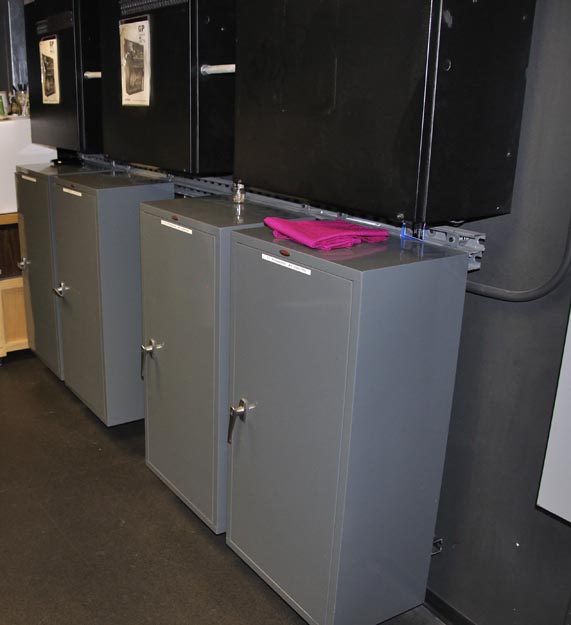
Each projector also has its own lens cabinet (Neumade LC-2). The conversion parts for each projector are also stored here.
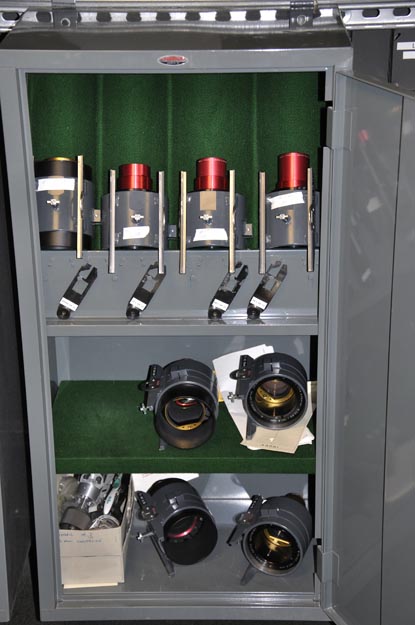
The lens complement for a 35/16 projector…the 35mm scope lens is in the projector. Each lens is stopped down, as necessary, to keep the light balance within SMPTE specs.
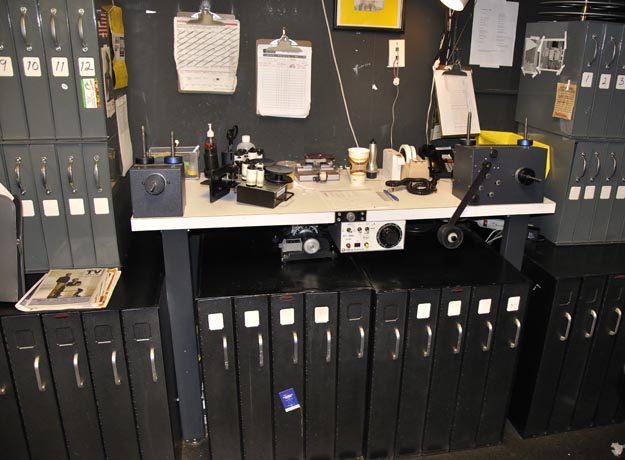
The rewind/inspection station in the Historic Theatre. The AFI/Silver runs a lot of film…as one can tell by the number of reel bins (and there are many, many more). They can fill them up pretty easily. Non-archival films are Film-Guarded (note the cleaner on the rewinder). The table was modified by the projectionists to make where the cleaner mounts more robust and easier to install/remove. They also have PTR rollers for archival or delicate movies.
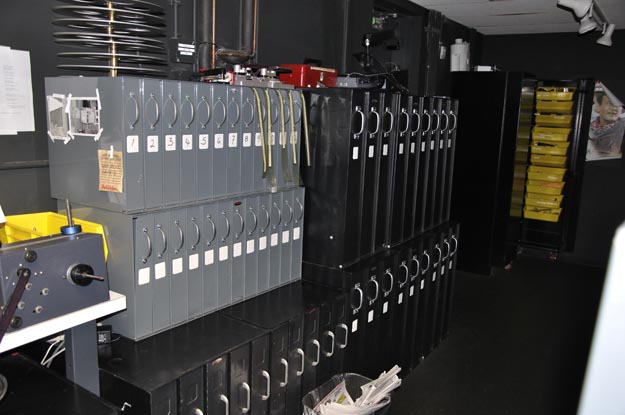
As I said, they have a lot of film and film bins and reels. The ones at the end are for 70mm. Believe it or not, they ran out of 70mm bins when running the Russian version of War and Peace.
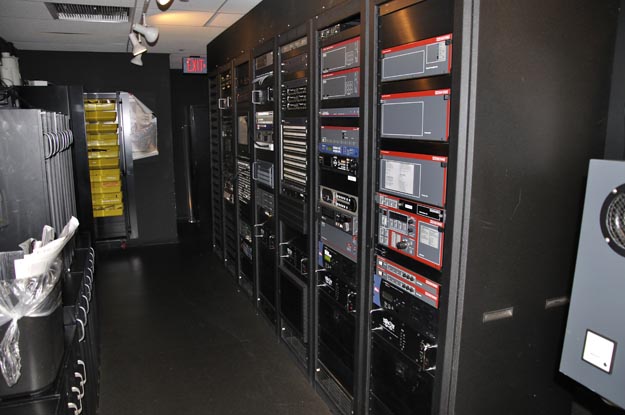
And now for the Historic Theatre’s wall of sound…and video…and PA.
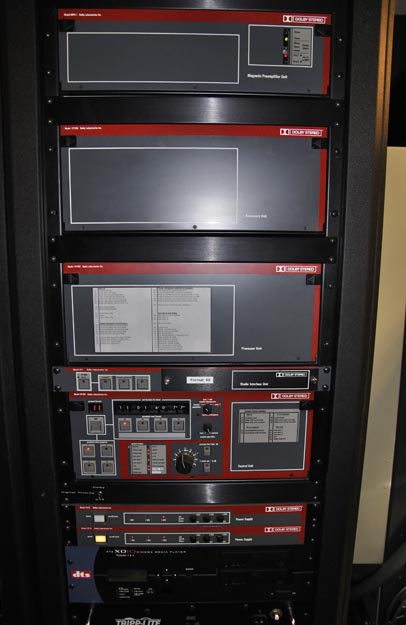
The finest processor ever designed, the Dolby CP200. Even in 2009, no other processor is as flexible. This one is reasonably well “tricked-out.” About all it doesn’t do is Surround-EX on board, though it could, the AFI has an SA-10 for EX. The unit below the Processing Unit and the Control Unit is the Studio Interface (SI-1). The MPU-1 is fully loaded for 35 and 70mm and has the Cat 93 for 4-track mag. surrounds.
Note too the switch that allows the projectionist to give priority to Dolby or DTS digital with the other serving as backup.
This CP200 is also integrated with the Crestron system. Dialing format 77 puts the Crestron in charge of the video format and source control. As one might imagine, this CP200 has more than just the stock format numbers.
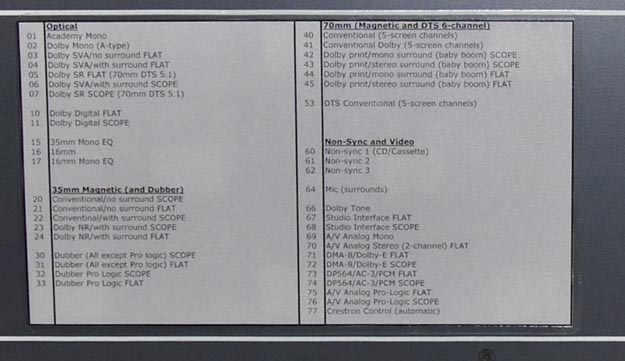
In fact, it has quite a few extra numbers. Wherever possible, format numbers correspond to Dolby’s numbers for other processors, like the CP650.
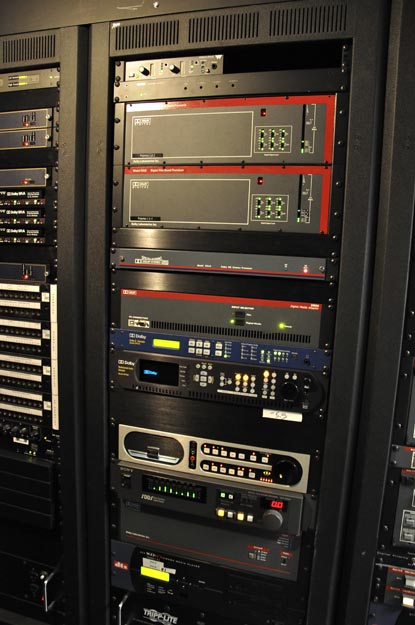
Moving down one rack we come the CP200’s Accessories. Two DA20s to handle all four projectors, SRA-5 for 35mm optical SR, DMA8 for digital audio from video/DCinema, DP572 for Dolby-E, DP564 for PCM and Dolby AC3, THX D1138 booth monitor and crossover, Sony SDDS DFP-D2500 (a rare bird but probably the best SDDS decoder and they make GREAT 8-channel VU meters!), the SA-10 for Surround-EX and the DTS-XD10 for projectors 1&2. The XD10 for projectors 3&4 is in the CP200 rack. The XD10s double as CSS units and allow for open captioning on select shows.
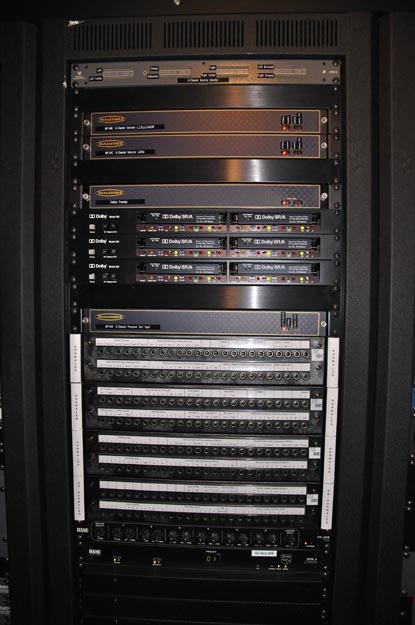
The next rack down continues the far reach of the CP200’s control. Panastereo MP64s are equipped with line cards to turn them into 4x1 6-channel input selectors. The CP200 can instruct the MP64s to select the desired input and the CP200 can choose which set of MP64(s) to listen to. Metering for video sources and those with potentially more than 6-channels are at the top of the rack with a Wohler 8-channel meter. Below the input selectors is another MP64 that has dubber preamps. The preamps are 6-channel and AFI/Silver has a separate preamp for each dubber head assembly. Below the dubber preamps are Dolby 363 SR/A noise reduction units so the dubbers may have either A or SR type noise reduction.
The Cinema patch panels are below the 6-channel (MP64) selector. This is where temporary sources can be patched in. One may also change the channel assignments of select equipment, including the dubbers and DTS players (special venue discs may not use standard 5.1 channel assignments).
Below the patch bays is a general purpose mixer for when the cinema system will carry some PA. It is also handy when you need to add a volume knob to a piece of equipment to balance its level out.
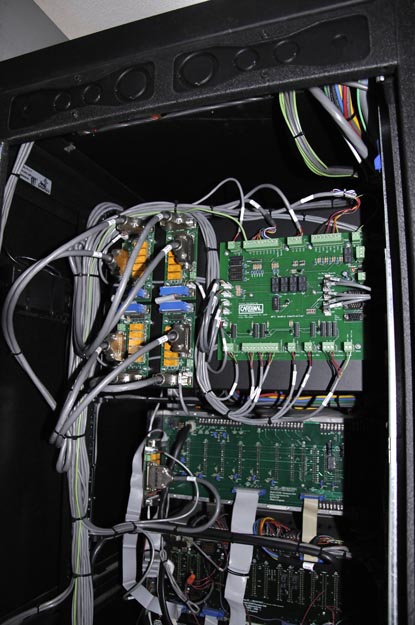
So how does the CP200 control all of these peripherals? Well we gave it some help. We developed a logic and buffer controller that lets the CP200 safely communicate with the MP64s, the Crestron and a couple other items. We use the CP200’s status to communicate to the outside too. The Cardinal board also handles projector arbitration so the various pieces of equipment are only functional when their projector is active.
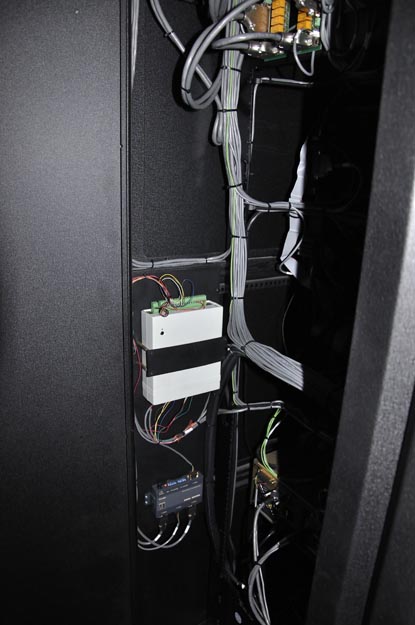
The Pennywise DF-1 is what allows the CP200 to take on a serial personality. It is quite versatile for functions like the fader, format selection…etc. It also allows the outside world, including the EMK-1 automations to “see” the CP200’s status too.
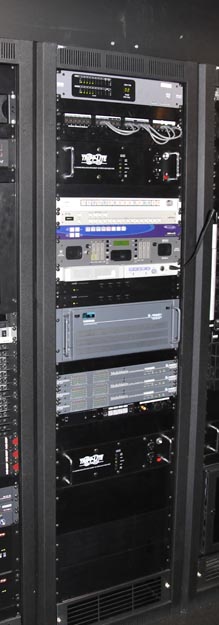
The next rack is bit of the “meeting of the minds.” In here the Media Matrix (used for automated PA functions, a full mixing console is used in the theatre for grander live events), Audio QC for video sources, CTA feed/control and such are housed.
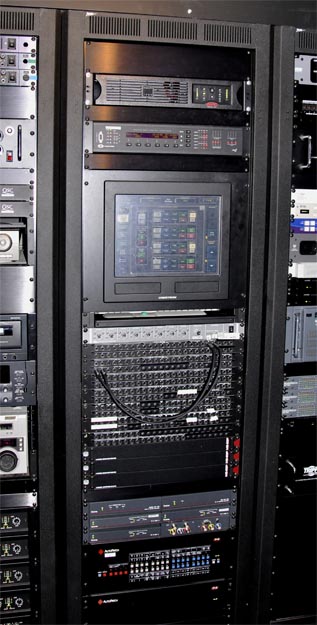
The Crestron and PA rack. The Crestron controller for the Historic Theatre as well as its main touch panel are here. Below are the A/V audio patch points as well as the A/V matrix switcher (AutoPatch).
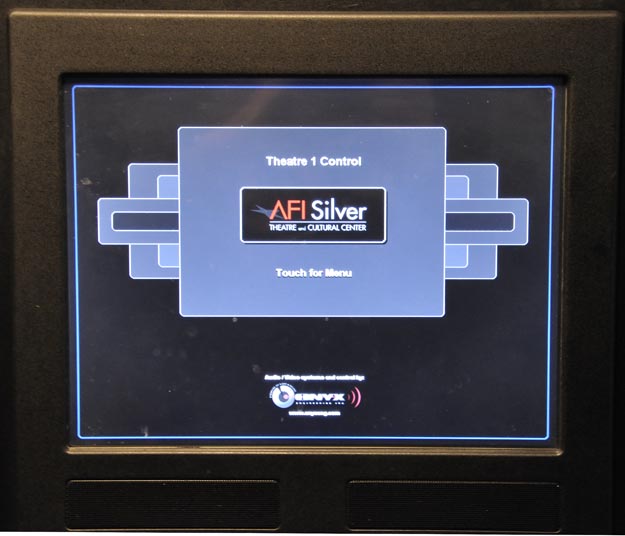
The Crestron system was designed by Onyx Engineering of Virgina Beach, VA. There were many contributions by Cardinal Sound as well as the projection staff of the AFI/Silver to get it into the extremely useful form it is in.
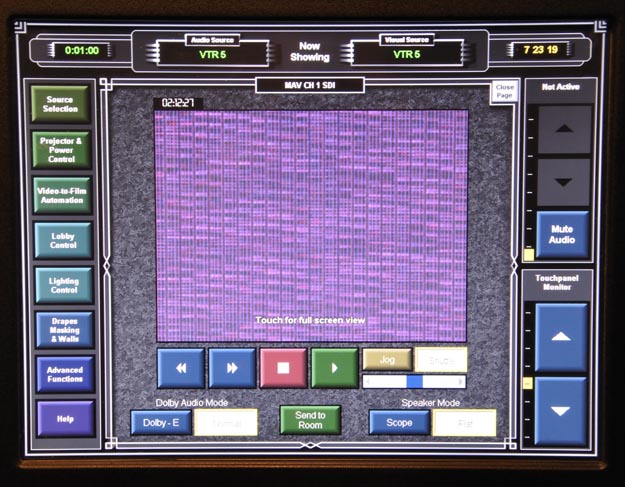
At the rack one has at least the same functionality that one has at the projection portals. However the extra space affords a more comfortable layout.
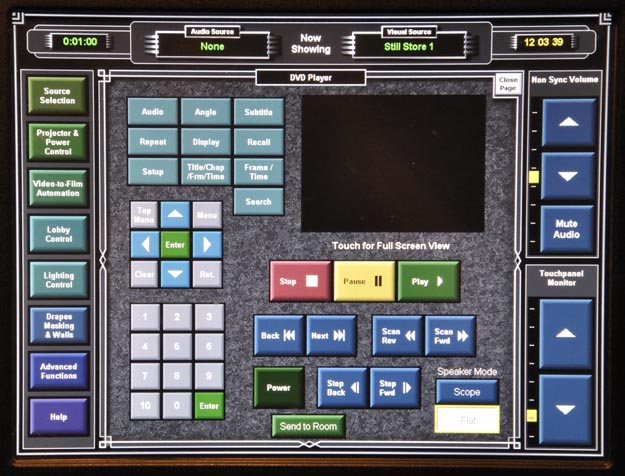
In some cases, the rack touch panel provides extra functionality that would be impractical or awkward from the smaller portal panels (DVD control pictured).
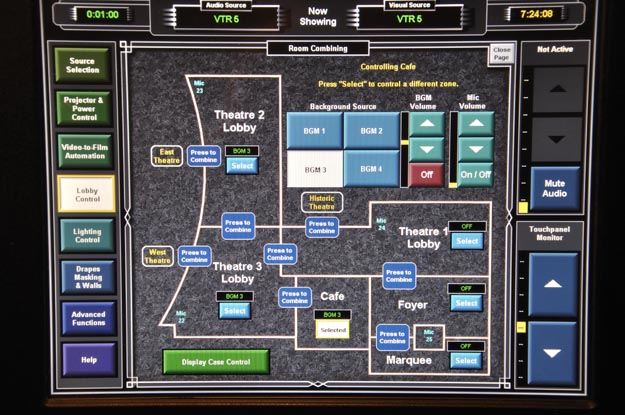
There are also some functions that have no application at the portal panels, like setting up the audio zoning for the lobby. Since events may take place in any theatre or any group of theatres, the lobby audio can be so zoned for the event(s) taking place.
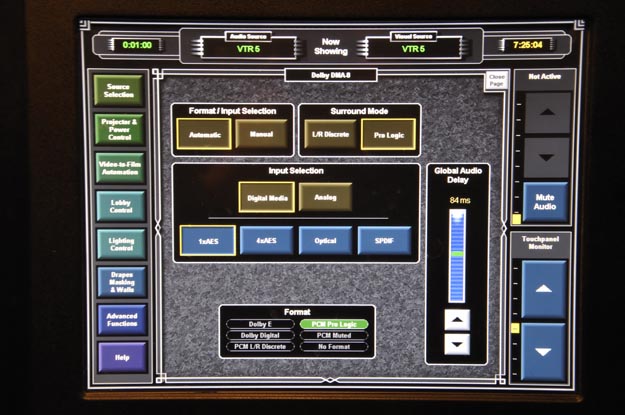
Ever find that the original Dolby DMA8 doesn’t have enough controllability or status indication? Not here.
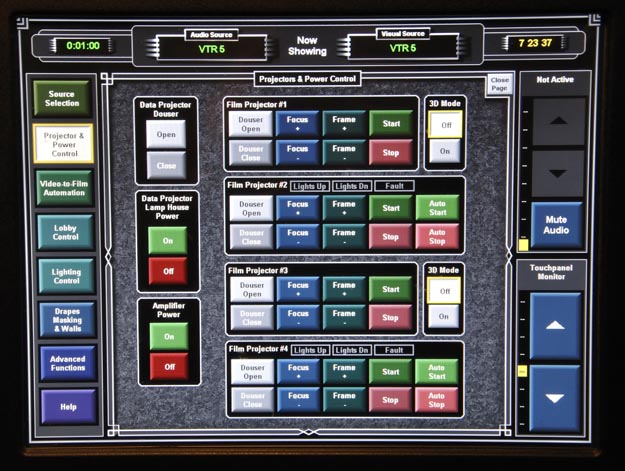
Even the film projectors are integrated. They can be controlled from the rack, the podium or even on a wireless remote. However, before a projector will start remotely, the Crestron panels (all) will sound a warning as well as instruct the projectionist to stand clear. Thus a film maker giving a lecture can control the projectors or, if necessary, for instructional or QC purposes. The digital projector is also integrated with the film projectors here.
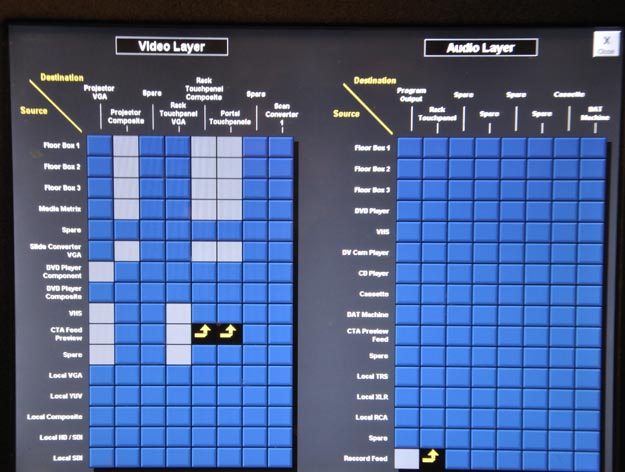
The matrix switcher screen provides real-time status as well as manual control over routes.
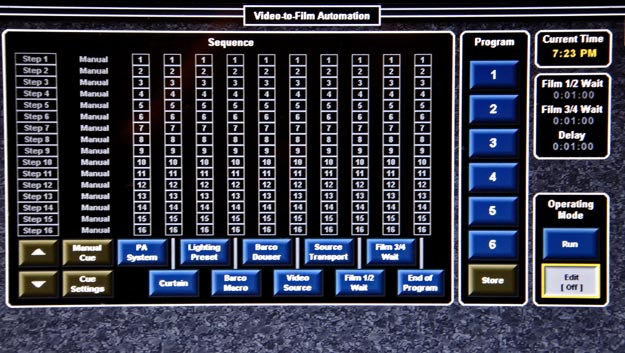
As mentioned before, the Crestron system can integrate the film and video performances…handing off the film portion to the EMK-1s and handling the Video and other house functions, including activating the PA system after the movie for Q&A or perform multiple video to film and film to video hand-offs. It is programmed by the operators much the same as the EMK-1
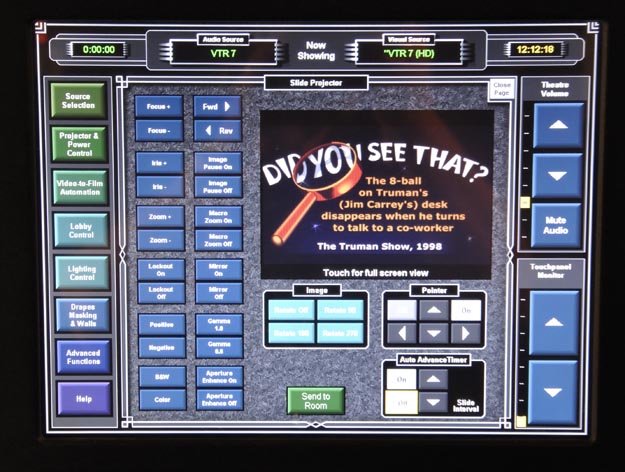
Most cinema folks will not have this much control over their slide projector. Yes, I said slide projector. Even slides are supported, electronically (art museums still use them and the AFI/Silver was designed in the late 1990s when slides were more prevalent).
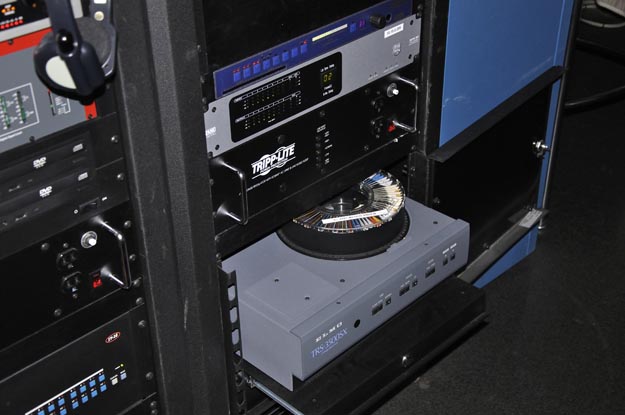
Each theatre has a pull-out shelf with an Elmo Slide tele-cine. Resolution is SXGA (1280x1024)…which, when the AFI/Silver was opened, was the resolution of Digital Cinema projectors.
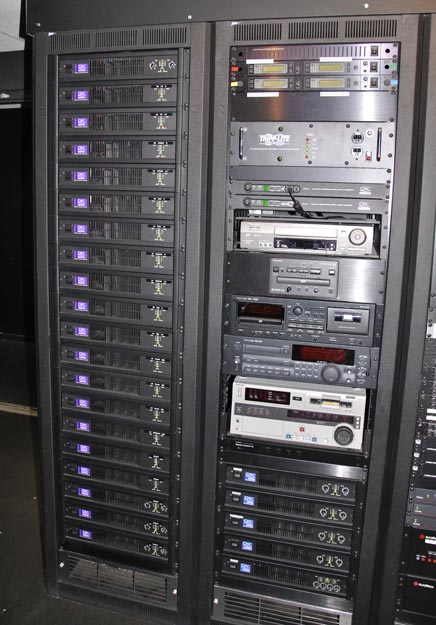
The last two racks in the Historic theatre contain the Cinema (left) and PA (lower right) amps as well as the few local video sources (DVD, DVCam, and VHS). The wireless mics, CD/Cassette player as well as the DAT recoder are in the right rack. Though the DVCam deck is in this rack, it is actually considered as part of the CTA and is selected/controlled just like any other CTA VTR.
Thus concludes the Historic Theatre’s equipment.
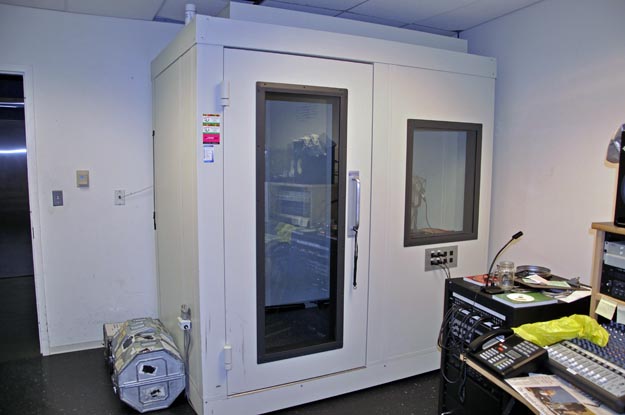
Located between the two projection booths is an audio recording booth. To the right is a video editing suite, primarily used for SilverDocs, the AFI/Silver’s annual Documentary Film Festival. Film prints are also generally received and shipped from this area
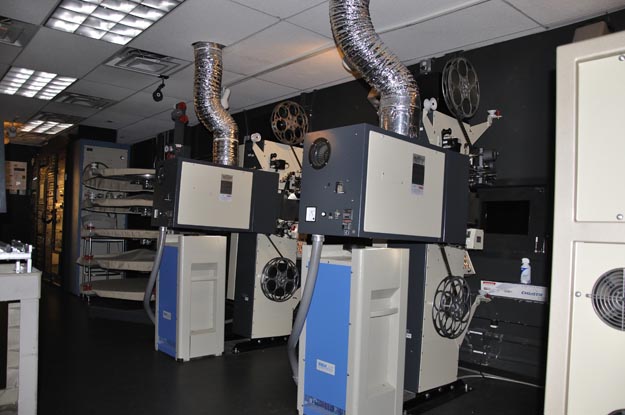
Entering the booth for theatres 2 and 3. Theatre #2’s equipment is on the right. A pair of Kinoton FP38ES film projectors (same as the Historic Theatre’s) and a Barco DP50. In the distance is a Kinoton ST500E platter and the A/V racks.
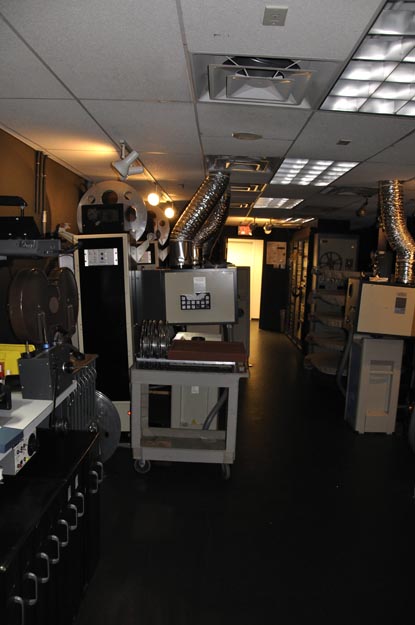
Theatre #3’s equipment is on the left as well as the other film inspection/rewind station.
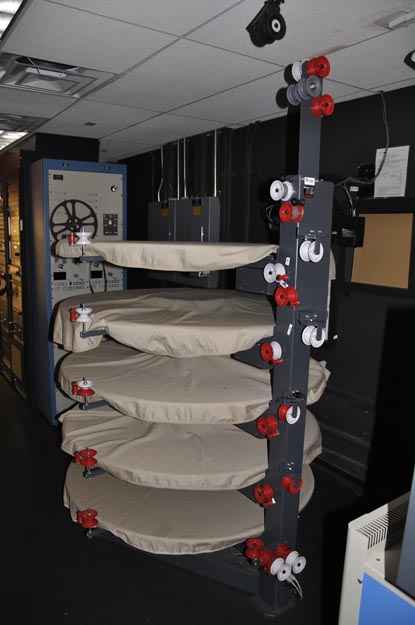
The Kinoton ST500E platter system in its “normal” mode (covered). The platter can be used with any projector for theatres #2 and #3. The platter primarily functions as a backup when running non-archival films. It can also be used if a feature is to have an extended run (every Sunday for a summer, for instance). However, since films are moved very frequently at the AFI/Silver, the overhead of putting the film on the platter makes it less favorable.
The dubber can be seen in the background. It is equipped identically to the one in the Historic Theatre. It can work with either theatre 2 or 3.
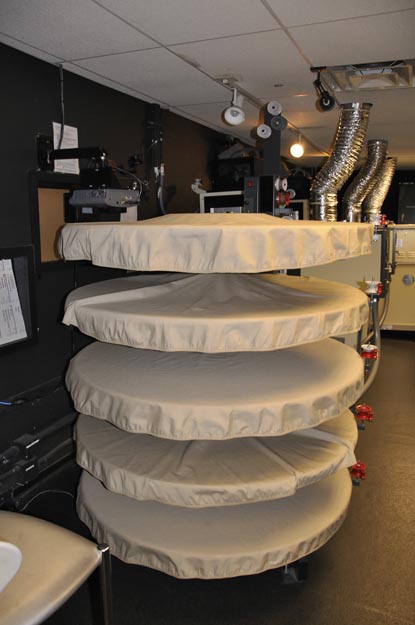
Located above the platter and also equipped in all three theatres is the captioning projector. Controlled by the DTS-XD10 players, open captions can be displayed over the film image for those that are severely hearing impaired or deaf. All three theatres also feature dual-channel headsets that can provide either the typical hearing impaired feed (stage channels, center weighted) as well as a “Descriptive” audio signal for the blind. Shows with open captions are normally published in advance.
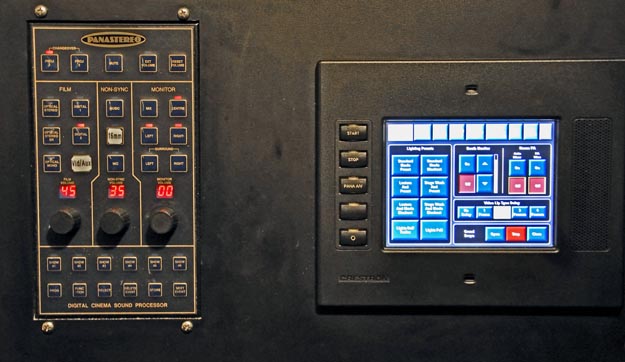
The portal stations for theatres 2 and 3 are similar to the Historic Theatre’s but the smaller theatres utilize a Panastereo sound system (CSP1200/CSP4600). The Panastereo remote control is on the left. Probably one of the best remote controls, ever, for a cinema sound processor.
The Crestron panel on the right is very similar to the Historic’s but is customized for the particulars of the smaller theatres. Functionality is kept similar for consistency between the various theatres. VTR controls are identical.
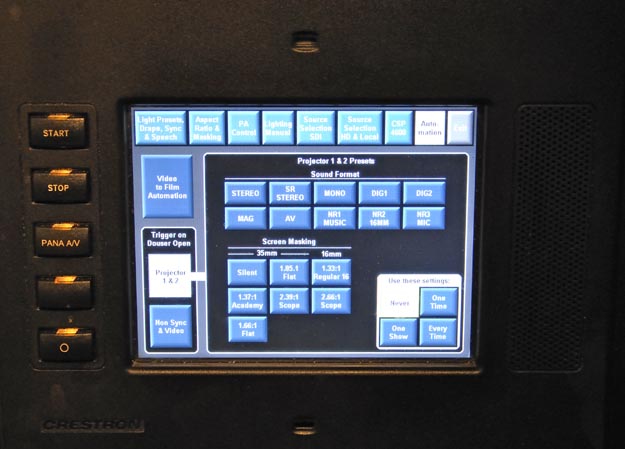
Presets for theatres 2 or 3 showing the particulars for the Panastereo sound options and the masking preset options.
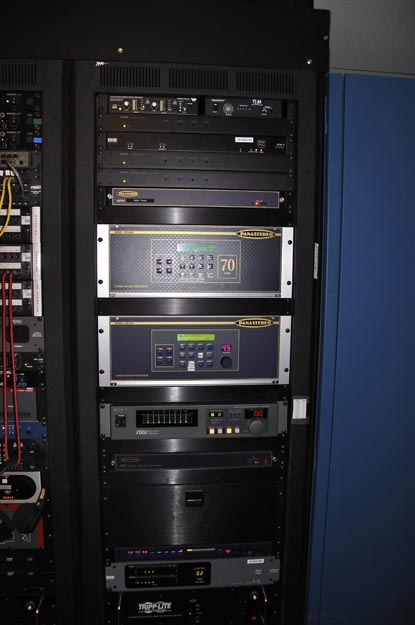
Theatre #2’s Cinema processor rack. It features the Panastereo CSP1200 processor. It is augmented by the Panastereo CSP4600 auxiliary unit. Despite the 70mm badge, the processor is not being used for 70mm here. The firmware was modified for the AFI/Silver so it could be effectively used as a mult-channel, multi-source selector. The CSP4600 also provides noise reduction for the Dubber (type-A or SR). There is a Panastereo MP64 above the CSP4600 for the dubber preamps.
Below the CSP1200 is an SDDS DFP-D2500 decoder. Theatre #2 is also has 5-screen channels while Theatre #3 only has three.
Below the SDDS unit is the Panastereo SP23 Surround-SX (same as EX) decoder. The SP-23 features 1/3 octave EQ on all channels as well as separate trims for all four sections for precise level matching of EX and non-EX movies.
Panastereo booth monitor (modified for line-out) drives the JBL LSR monitor speakers throughout the booth. The Panastereo remotes have monitor selector and volume controls as well so the projectionist is never far from a control.
The Rane RPM88 DSP processor, among other things, provides for accurate lip-sync delay for video sources.
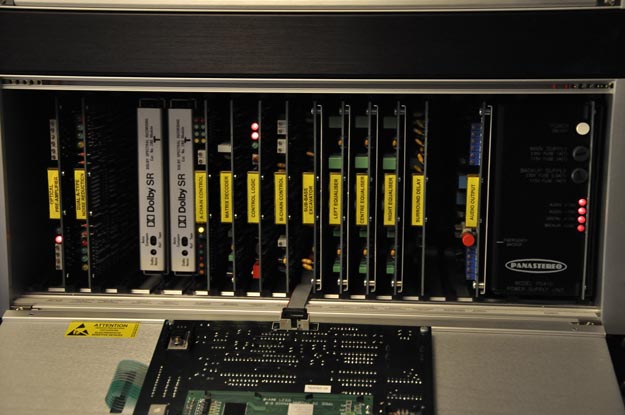
Open up and say “ahhhh.” The CSP1200s are fitted with genuine Dolby Cat 280s for 35mm SR reproduction.
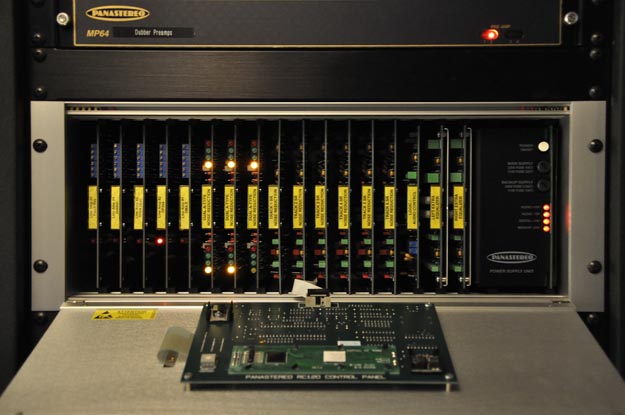
The insides of a CSP4600. The dubbers use Panastereo SR (CM353s). The line input modules on the left side select which source is desired. Left-Center/Right-Center EQ modules are on the far right.
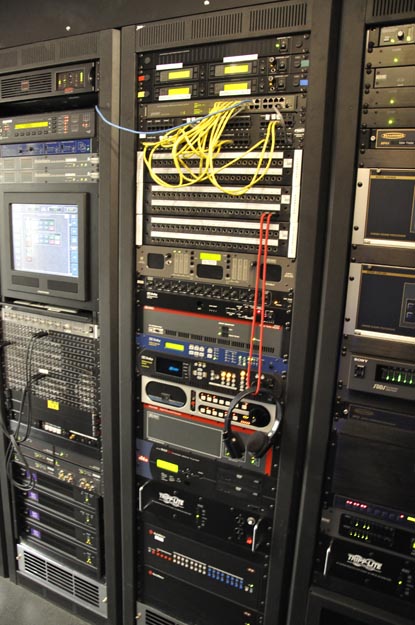
The next rack clearly shows why Ethernet switches belong in the back of a rack (as do Ethernet patch bays)!
The patch bays (Cinema audio), Video’s audio monitoring, Rane Mixer (general purpose), Dolby SDU4 (analog Pro-Logic), Dolby DMA8, Dolby DP572 (Dolby-E), Dolby DP564 (AC3/PCM), THX D1138 (monitor and crossover), DA20 and DTS-XD10 (audio and CSS functions) are in the next rack. The A/V matrix switcher is at the bottom (AutoPatch).
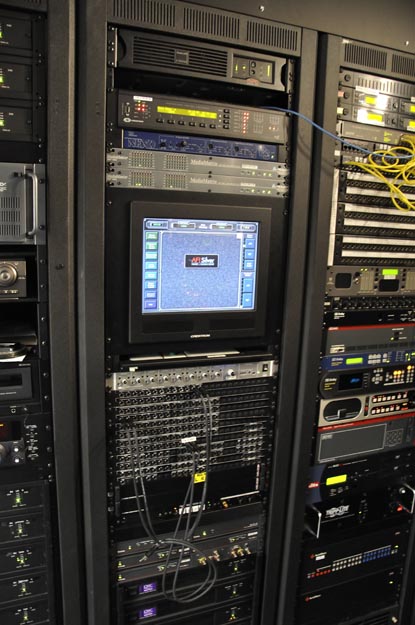
The next rack down houses the Crestron system for Theatre #2 as well as the PA patch bays with some of the Cinema amplifiers at the bottom.
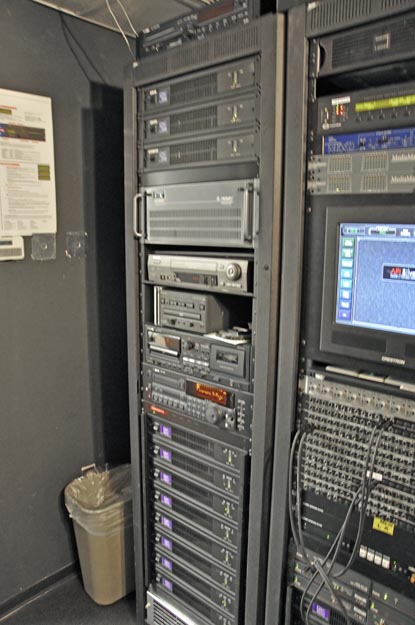
The last rack contains the PA amps, Media Matrix for theatres 2 and 3, the local video and audio sources and the Cinema amps.
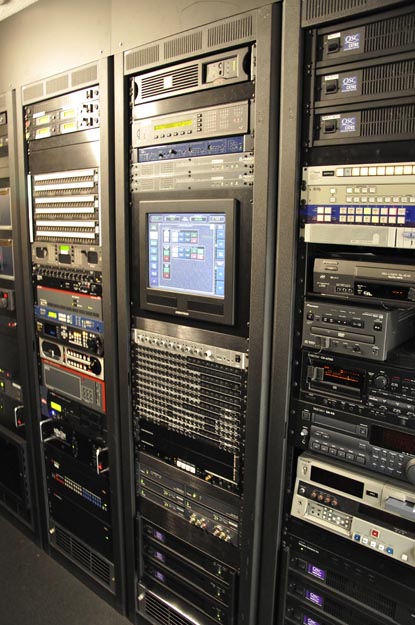
Theatre #3s racks are nearly identical though a mirror image.
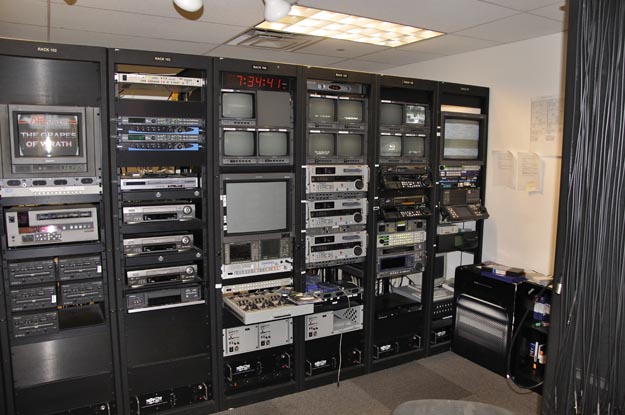
The VTR bank in the CTA. The DVD players on the left are primarily for the display cases in the lobby. The VHS decks are primarily for duplicating in-house productions for distribution. These racks contain the DVCams, HDCams, D5, the MAV777 and even the Qvis Qbit video server. This also doubles as a workstation where “shading” and other video tweaks may be performed on live shoots.
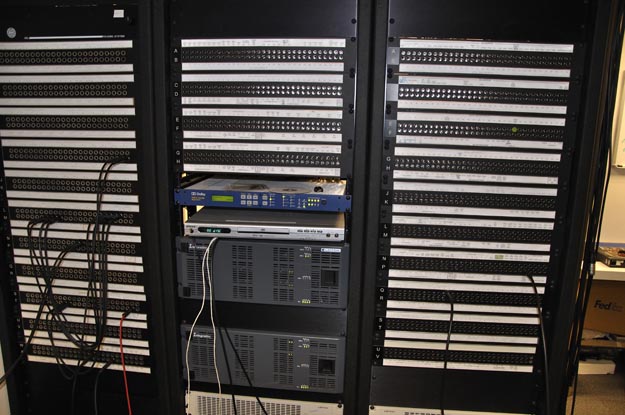
Opposite of the VTR racks are the Video and Audio Patch bays. Here, analog audio, digital audio and Video may be patched as needed. The middle rack also contains the routers, and Dolby-E encoder.
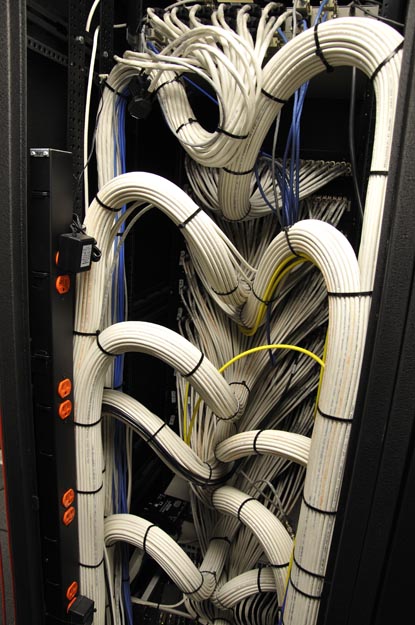
Care to wire a video patch bay? How about a stack of them?
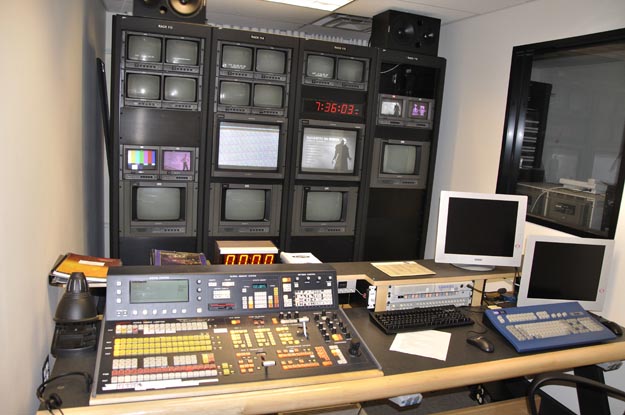
The video production suite.
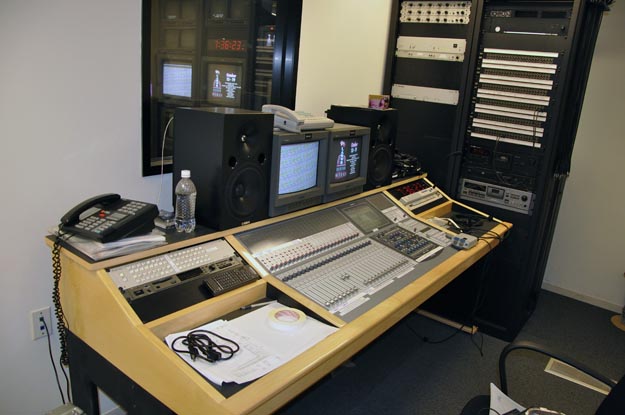
And right next door is the audio production area (you can see the video production area through the window).
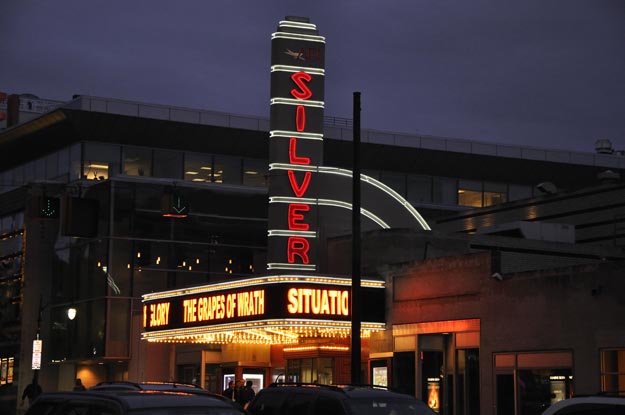
The AFI/Silver. One of the best places to see a movie of any age!
Special Thanks to:
Mr. Ray Barry: Director of the AFI/Silver
Mr Don Scheuerman (Montgomery County Chief Engineer), who’s very broad shoulders seemed to carry the AFI/Silver through to completion.
The technical and projection staff at the AFI/Silver, without whom, all of this fine equipment would not accomplish what it does and with such professionalism on a daily basis.
The Design and Build Team:
The Architects of the AFI/Silver and Cultural Center: Gensler
The designers of the Audio Visual Systems: Boston Light & Sound (Thanks to Larry Shaw and Chapin Cutler).
Cinema, Projection and Sound Systems Installation: Cardinal Sound & Motion Picture Systems, Inc.
A/V, PA and Crestron Installation: Onyx Engineering
Broadcast Installation: Sony Integration.
General Contractor: Foulger-Pratt.
All photos except the B&W 1952 photo are © from the Steve Guttag collection and may not be used, distributed or duplicated without permission. The B&W photo has been commonly circulated without any copyright information. The copyright holder, if any, has been sought but not found. The Crestron layouts are also copyrighted.
| 
 Home
Home
 Products
Products
 Store
Store
 Forum
Forum
 Warehouse
Warehouse
 Client Login
Client Login
 Contact Us
Contact Us

































































































